Carrots are a very necessary vegetable in the kitchen! All the year round, we add it to hot dishes, eat it fresh and mix salads. The cost of carrots in the store is not high, so maybe it would be more convenient to just buy root vegetables as needed, without spending time to grow it? However, closer to spring, shop carrot begins to increase significantly, its quality is deteriorating noticeably, and those who did not make reserves in time, it is difficult.
That is why in each garden there is always a vegetable garden under this favorite vegetable culture, and seasoned truck farmers exchange with the beginning experience how correctly to plant carrots in order to obtain a rich harvest of healthy roots.
Photo of soil preparation for carrots
If before you did not have to grow vegetables, and you have no idea how to plant carrots, or you can not grow normal, delicious root crops, our article will certainly be useful to you. We will talk about how to plant carrots with seeds, how to care for young shoots, and how to protect the garden from diseases and pests of carrots. Video about preparation of carrot seeds for planting
Depending on what kind of seeds you bought, the timing of their sowing will also differ. So, in the twentieth of April you can start sowing early ripening varieties, from April 25 to May 5, they begin to sow mid-ripening varieties, and planting carrots, intended for winter storage, is held June 10-15.
Under the carrot patch is recommended to choose a site where the weeds do not appear too much, because the weeds will get up before the carrots and prevent it from growing. The soil must be loose, preferably with a sand content. In heavy ground, root crops can turn out to be curved, sloppy, shallow. If the ground is constantly elevated moisture levels, the root crops rot, and in the dry earth the carrot will turn out to be "wooden".
Consider also, after what crops you will sow carrots. It is best to choose those sites on which cucumbers, tomatoes, garlic, onions, cabbage, potatoes or greens grew last year (except for salad). After parsley, it is better not to plant carrots, since pests, dangerous for carrots, can remain in the soil.
Photo of carrot seed
Soil in the garden dig in the fall, and in the spring walk on the ground flat-cutter. In addition, do not dig - for carrots preferred settled land. Most importantly - do not apply fresh manure to the soil, since the carrot does not tolerate its acid. The bed can be fertilized with mineral fertilizers a couple of weeks before planting carrots.
Planting of carrots is done by seeds directly into the open ground. Seeds prepare in advance:
- soak for two hours in clean water at room temperature;
- scatter the seeds on a damp cloth and cover the top with another damp cloth;
- keep the seeds in the room, periodically mixing them gently;
- soak the cloth when it dries;
- when the seeds are completely swollen and begin to peck, move them to the refrigerator for 10 days for hardening.
Easy and affordable about how to plant carrots correctly
Photo of planting carrots
The carrot seedbed should be sprinkled with ashes, cut through it into every groove up to 2.5 cm deep, leaving a row spacing of 20 cm, and along the edges of the ridge of 12 cm. Pour grooves with water and remove prepared seeds. It is enough to maintain the distance between the seeds at 1.5 cm. Felt the furrows with earth. Above the bed at a height of 15 cm is recommended to pull the film so that shoots appear faster, and with the appearance of green film can be removed.
Experienced gardener in an effort to simplify the process of sowing seeds, sometimes invent quite unusual methods, how to plant carrots: someone before seeding mixes the seed material with sand, while others pre-paste one seed on a tape of thin paper (you can use a toilet). The carrot seed is picked up with a toothpick, dipped in a paper glue or in a paste and applied every 5 cm to the paper. Such paper tapes are laid in furrows and pour over the ground. Video about growing carrots
On the edges of the bed plant a radish, it will quickly rise, indicating the carrot rows, and you can start loosening the lines early (carrots very fond of frequent loosening). It is also very useful to plant a onion on the carrot, as its smell removes carrot flies, the most dangerous pest of carrots.
The first time the garden should be watered abundantly, and when the first shoots grow green, reduce the watering up to two times a week. Although the seed material does not grow all the way, but the shoots will still have to be thinned after the formation of the first leaf, leaving the most powerful plants.
orchardo.ru
Planting carrots in spring - grow carrots-giants!
How to plant carrots in the spring - it's all about the soil?
There is no big mystery in good harvest - the carrot will grow almost by itself to impressive sizes in light, loose and nutrient loam and sandy loam, but on hard clay and waterlogged soils you will get pale and clumsy roots. Stagnation of moisture for her in general is fatal! But the drought will not turn out good either - the root crops will be fibrous, rough.
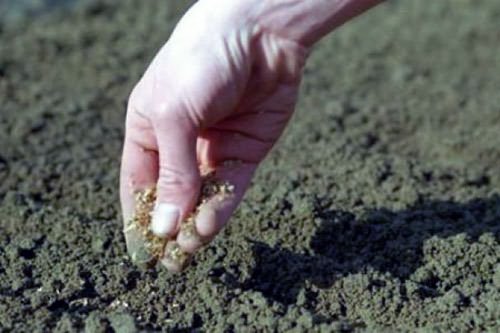
- Carrot storage time
- When to plant a strawberry in the spring
So look for the golden mean - the land should be properly hydrated with groundwater lying at a decent depth. As in the case with beets, planting carrots in spring on a freshly fertilized manure is extremely undesirable, because root crops tend to accumulate nitrates, and they can become poisonous.The level of acid balance is also important, because carrots do not like acidified soils.
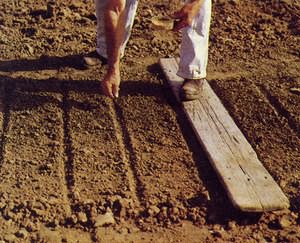
When and how to plant carrots in spring - the time frame
Traditionally truck farmers sow carrots in April or even May for more northern regions, however, it is possible and the option of sowing for the winter in November, because the plant itself is frost-resistant. Pick up for carrot beds should be well-lit places that will literally bathe in the sun throughout the day. If the soil on the plot is heavy, add sand and peat to it, half a bucket per square meter, if the soil is poor, fertilize it with peat, turf, humus and mineral fertilizers.
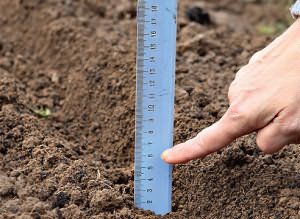
Sow the seeds in narrow furrows, which should be done at a distance of not less than 10 cm from each other. It is recommended to pour them with hot water and sprinkle with ashes or chalk. Seeds should be sown at a distance of about a centimeter. In a thicker sowing, there is no sense, because all the same you will have to leave only the strongest plants, and the rest will pull out. If the plants are located too close to each other, then when thinning, you can damage the roots of the remaining ones, which is why it is recommended not to sow carrots densely.

To plant a carrot smoothly, you can buy or make a paper tape with glued starch glue seeds. All that needs to be done in the spring is to spread the ribbon along the furrow and prikopat it with earth. This is the most even way, although it will take a lot of time to spend on it. It is much easier to place the seeds in a salt shaker with large holes and shake over the prepared grooves. Whichever way you choose, seeding carrots in spring will still end in thinning!
Planting carrots in spring - the first shoots and thinning
Carrot likes to stay long in the ground - sometimes sprouts appear almost a month later. At this time, the weeds are already full of weeds, so some summer people sow together with carrots and seeds of lettuce or spinach, which serve as beacons for gardener. In the layout of the garden, consider that the best predecessors for root vegetables are tomatoes, cabbage and potatoes.

As soon as the first leaves have appeared, it is necessary to undertake thinning. Many truck farmers do not hurry, waiting for the roots to become edible. However, this is a mistake that will reduce your harvest several times - root crops will interfere with each other, deform and stay in development. Therefore, after the first thinning leave between the plants 3-4 cm, after three weeks, double the distance. Each thinning should be completed with copious irrigation.
Watering beds with this root is in principle necessary regularly, in warm sunny weather at least once a week in a bucket of water per square meter of beds.
What kind of carrots to plant in early spring to get an earlier harvest? There are many early, middle and late varieties. If the first are intended for the first salads and vitamin juices, then the second and third - for the autumn and winter consumption. Every trucker decides which carcass delegates he will invite to his own beds.
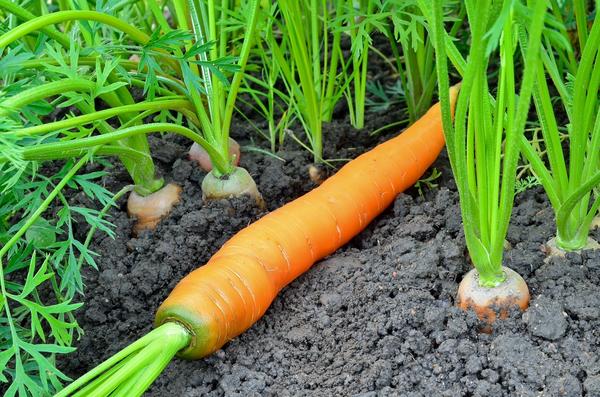
nasotke.ru
How to plant carrots?

The friendship of a man with a carrot lasts more than one millennium. During this time, people have come up with not only a thousand and one ways how to make carrots, but also dozens of ways how to plant it.
How to choose a place for planting carrots?
For cultivation of carrots are suitable well-lit areas with sandy loamy soils, not subject to the danger of stagnation of groundwater. Do not put carrots on the same site for several years in a row. It is best to choose for her beds where cabbage, potatoes, garlic, cucumbers, onions, greens and tomatoes grew up before.
How to properly prepare the carrot seeds for planting?
Seeds of carrots have a fairly dense shell, due to what they spend a lot of time on germination. To accelerate this process, the carrot seeds should be pre-sown in warm water for two to three hours before sowing, and then put on a folded several times wet gauze. After swelling, carrot seeds are sent for 10 days to a cool dark place for hardening.
How to plant carrots with seeds?
To facilitate further care for carrot beds, it is very important to evenly distribute seeds along the bed during the sowing process. This is not easy, because the seeds are very small. But ingenious truck farmers invented a variety of ways how to plant carrots with seeds evenly. The simplest of them is to mix the seeds with dry river sand and sow in pre-made grooves. It is also convenient to use ready-made granulated seeds - carrot seeds in a shell from a mixture of nutrients. But it is not always possible to buy granulated seeds of the desired variety. If desired, you can make a nutrient solution for the seeds yourself, by welding a jelly from starch and water with the addition of mineral fertilizers. When the jelly will cool down, seeds of carrots are added to it and distributed over the bed, pouring into a culinary syringe or a cut off bottle. But the most convenient way how to plant carrots with seeds is to plant them on a tape. In this case, the tape with the seeds attached to it is simply stretched over the bed and sprinkled a little on top of the ground. Over time, the ribbon decomposes, and the seeds sprout, forming a beautiful neat garden.
When to plant carrots?
Carrots are one of those crops that can be planted both in spring and winter. Choosing when to plant carrots - in the spring or for the winter - is necessary depending on when you want to harvest and how to plan to dispose of it. If carrots are planted for long winter storage, then it should be planted in the spring. Short-term storage is suitable for early ripening varieties of carrots, which must be planted in autumn. Autumn planting of carrots has a number of advantages. First, it releases part of the time, which is already in short supply in the spring. Secondly, seeds for autumn sowing must not be prepared beforehand.
When to plant carrots for the winter?
The time to plant carrots under winter comes in the first decade of November, when the ground has not frozen yet, but it's still warm enough to carry out planting works. Earlier, planting carrots does not make sense, because at higher temperatures it can germinate, and then it will freeze at the first frosts.
When to plant carrots in spring?
The timing of the spring planting of carrots depends on what type of carrots are sown. Early-ripening varieties of carrots begin to sow in early April, when there is no danger of recurrent frosts, and soil temperature does not drop below + 5 ° C. Carrots with an average maturity period are sown in late April-early May. The time to sow late varieties of carrots comes in early June.
womanadvice.ru
Spring and autumn planting carrots - what's the difference, and what to prefer?
You are accustomed to planting carrots in spring and every time you are looking forward to when you can try fresh roots. Planting carrots in autumn will allow you to harvest the first harvest much earlier than usual! Moreover, root crops will be less susceptible to diseases and pest attack, and may grow in size larger than spring carrots.
What is the difference between the spring and autumn planting of carrots?
You are accustomed to planting carrots in the spring and every time you are looking forward to when you can try fresh roots. Planting carrots in autumn will allow you to harvest the first harvest much earlier than usual! Moreover, root crops will be less susceptible to diseases and pest attack, and may grow in size larger than the spring carrot. Many truck farmers do not like the autumn planting of carrots for the simple reason that it will have to provide good protection of seeds from bad weather. However, it is not so difficult in reality, the main thing is to correctly calculate the planting time and use the appropriate varieties of carrots.
It is only worth noting that the carrot, planted in the fall, is not suitable for storage, you will need to eat it right away. Therefore, the garden does not form too large so that the ripe carrot is not wasted. Video about planting carrots
Planting carrots for the winter is needed not only to get the extra early harvest. Another advantage of podzimnego sowing is that you can save a lot of time in the spring, when the hassle in the garden is already enough. So, planting carrots in the spring takes time to prepare the beds, to soak and dress seeds so that they better rise, and directly to the sowing. In the autumn, you can slowly plant carrots after all the main works in the garden have been completed. In addition, you do not have to bother with seeds - they will have time to be saturated with moisture, being in the soil, and will pass a natural hardening during the winter, which will ensure more amicable early shoots.
The difference between planting in spring and winter is also that in autumn you will need to carefully select a site for carrots: in a windless place where snow melts the most, while the site should be strictly horizontal, so that in spring waters the planted seeds are not washed from the soil .
On the photo planting carrots
Otherwise, there is no particular difference at what time of the year to plant carrots. The technology of tillage and sowing seeds is the same in both cases. And caring for a carrot planted under winter with the arrival of spring will not differ from caring for carrots planted in the usual time.
How to plant carrots for the winter?
The first question that naturally arises: when to plant carrots in the fall? After all, the main task is that the seeds do not germinate before the onset of colds - during the winter they only need to swell, and ascend after melting snow. If you plant a carrot in October, the seeds during the thaws will have time to penetrate and begin to rise, then with the first frosts all the sprouts will die. To long not doubt, when planting carrots for the winter, schedule seeding in the middle of November, and the norm of seeds for sowing increase the percentage by twenty - in case, if not all the seeds will ascend.
Soil in the beds and dig up and loosen immediately after harvesting predecessors of carrots. Add mineral fertilizers and humus, for acidic soil add more wood ash, and mix the heavy soil with sawdust or sand so that the carrot does not grow clumsy and horned. In addition, it is recommended to disinfect the garden with a solution of carbophos.
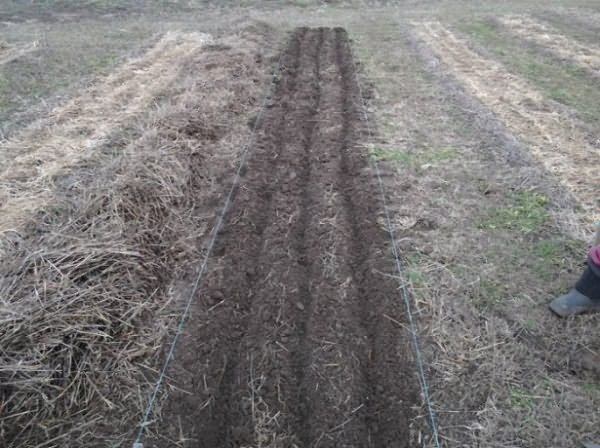
Instructions for sowing carrots for the winter:
- form beds in a height of 15 cm, so that the water in the soil does not stagnate;
- cut the grooves deeper than on the spring beds, taking into account the soil draft (5 cm is enough);
- spread dry seeds into the grooves;
- above, sprinkle seeds with soil mixed with peat or sand;
- soil a little compact, so as not to blur in the spring;
- close the garden with cut branches, stems of raspberry, lapnik.
Video about growing and planting carrots
Conveniently, when the soil that you fill the grooves, differs in color from the main one - then in the spring you will clearly see where the rows of carrots and where the weeds appear. And it will be easier to loosen rows between rows.
After the carrot planting in autumn was successfully completed, you can safely wait for spring. In the winter, there is no sense in touching the garden bed, it will be useful only to scrape the snow from the tracks to the bed - the seeds will be more comfortable to winter under a fluffy snowdrift. In the spring, the snow melts slightly, the lapnik and branches from the carrot patch will have to be removed, covering it for a while with a film, so that the sprouts appear faster. Well, further care for carrots will be quite standard: watering, weeding, loosening, feeding. With proper care in June, you can already collect fresh juicy carrots!
orchardo.ru
You are here: Agroinfo »Articles» How to plant carrots?
- Welcome to AGROINFO AGROINFO! Our main directions: agricultural machinery, a review of prices for agricultural machinery (tractors, combines, cultivators, harrows, plows, seeders, reapers). agroinfo.com - the most affordable, among effective, channel for promoting agricultural products in Russia. You can read the latest news from AGROINFO in Yandex
Rostselmash
How to plant carrots?
Depending on the purpose of the product, there may be three different periods for sowing carrots: to obtain the earliest harvest in the form of bundle products, it is advisable to sow part of the seeds under the winter after the soil freezes or before freezing, the second part - in the early spring, as soon as possible to enter the garden, the readiness of the soil on the beds prepared since autumn, and, finally, the third part - in the summer for long-term storage, in beds, dug up in the spring.
The best predecessors for carrots are beans, tomatoes, cucumbers, early green vegetables.
How to plant carrots?
Seeds of carrots are sown only in moist soil - in no case in the dry. It is important that they manage to use the reserves of moisture accumulated in the soil, and then the shoots will be friendly. Sow as early as possible as the soil is ready and meteorological conditions. At a soil temperature of 5-8 ° C shoots appear on the 6th-8th day.
Before sowing on prepared rift-leveled beds, grooves are made at a distance of 18-20 cm from each other and a depth of 5-6 cm. The bottom of the grooves is sprinkled with loose soil, watered and rolled. Then sow the seeds, as evenly as possible, to a depth of 1-1.5 cm. The grooves are covered with soil, slightly compacting it to better contact the seeds with the soil and pulling moisture to the seeds, spraying with water and mulching dry peat with a layer of 1 cm.
To accelerate the emergence of seedlings, crops can be covered with a translucent film in a single layer, but so that there is 5-6 cm between the soil and the film. Under the film, the shoots are more even and do not form a crust on the soil. As soon as the shoots appear, the film is immediately removed to avoid stretching.
Podzimniy sowing
For the earliest harvest, the seeds are sown for the winter. Choose an even, meltwater-free, sheltered from the wind and clean from weeds with a light soil, where there is no danger of the formation of an ice crust. The beds begin to be cooked as early as possible, already in September and October: they remove all the plant remains of the previous crop, while removing the perennial weeds, immediately after harvesting the soil, the soil is digged to a depth of 22-25 cm, if necessary, humic and phosphate-potassium fertilizers, whose composition depends on what was made under the predecessor, and also on the quality of the soil. If a lot of organic fertilizers were introduced under the previous culture (for example, for cabbage or cucumbers), then they are not necessary.
If there is a dry autumn, the dug up beds are poured, to provoke the growth of weeds, and then destroy them. Before the stable frost, the surface of the beds is once again carefully leveled so that there are no depressions and cut grooves 4-5 cm deep. By the time of sowing, the soil is still compacted, and the depth of grooves will be at a level of 3 cm. In addition, the bottom of them before sowing should be still covered with a small layer (1-1.5 cm) of humus, compost or peat, in their absence - sand or soil. These components are harvested in advance and kept before sowing in a sheltered place from the rain.
Prepared grooves are left until the soil freezes. When to plant carrots for the winter? Seeds are sown when a constant temperature is established (below 5 degrees Celsius). If the groove is covered with snow, it is swept out with a panicle immediately before sowing the seeds, the prepared compost, humus, sand, seeds are poured into the grooves with a layer of 4-5 mm, seeds are sown and sprinkled with the same components. Then mulch a small layer of peat or other material.
Sow must necessarily dry seeds. The rate of sowing per unit area is 25-30% higher than in spring sowing. In this form, the crops are hibernated.
In spring, shoots of the sub-winter planting appear one to two weeks earlier than the spring one. Seeds sown in the autumn and even in winter, exposed to cold and frost, pass through natural hardening, so plants that grow from them are better tolerated by spring frosts, form a more powerful root system that allows them to use winter moisture. Shoots appear very early, with the first heat, so they are less damaged by pests. But the most important advantage of podzimnego sowing - vitamin yield can be obtained 2-3 weeks earlier than in spring sowing.
Which carrot to plant for the winter? Preference should be given to varieties that are well established in the harsh winter conditions - Nantes 4, Nanteska 14 (the fastest forms the root crop), Moscow winter A-151, Leningradskaya, Incomparable, NIIOKh-336, Vitamin, Canning, Olympia, Shantane.
It should be remembered that the carrot of the sub-winter planting is intended only for summer consumption. It is not left for storage.
Care
Care for carrot crops is the loosening of rows, especially after precipitation and watering, the destruction of weeds throughout the growing season, thinning out sprouts, protecting against diseases and pests, fertilizing fertilizers and watering. The most important thing is to carry out all these activities on time and with skill.
Many people are interested in how to plant properly carrots. Sow carrots are usually somewhat thickened, and not only because of reduced and uneven germination, but also in order to have some reserve in case of plant damage by diseases and pests. Initially, a dense stand favorably affects the growth, because in the early stage of development of carrots for the first month uses only 1% of the area. Later shoots come into competition, as they already lack food, moisture and light. The plant is stretched, and the roots are formed ugly, the plants develop slowly - thinning is required. It is necessary to create an optimal area of nutrition, timely remove superfluous and, in the first place, weak plants. In most cases, the plants must be thinned in several steps, first combining with the first weeding in rows, after the formation of the first real leaves with a plant height of 5-7 cm, leaving the distance between the plants 2-3 cm. The second time the carrots are thinned when the diameter of the root crops reaches 1 , 3-1.5 cm. After that, the distance between the plants for the early varieties should remain at least 3 cm, for the late 5-6 cm.
When thinning, it is necessary to remove the weak ones and leave more powerful plants, sprinkle the ground to them, to prevent the eggs from being laid off by the carrot fly, attracted by the smell of essential oils of carrot leaves.
If the shoots appeared unevenly (slices), the thinning is carried out in the cotyledonous state, without waiting for the appearance of real leaves.
Watering
Simultaneously with the breakthrough the soil is loosened, the crops are watered. An important condition for high-quality carrot harvest is the uniformity of moisture throughout the entire growing season. Watering crops increases the yield by 1.5 times, improves the commodity and flavor qualities of root crops. With a lack of moisture, they become coarse and woody.
Carrots should be watered moderately and regularly, once every 8-10 days at a rate of 6-8 liters of water per 1 m2. Excessive hydration leads to increased growth of the tops and a delay in the growth of root crops, and even a short stagnation of water in crops can lead to complete loss of plants. With a sharp transition from dryness to high humidity, root crops crack. If, for some reason, there was a delay in watering, then, resuming it, first water the plants poorly - 3-4 liters per 1 m2. A day or two watered with a higher dose - 5-8 liters per 1 m2. When watering, water is poured gradually, to a good moisture level to a depth of 12-15 cm. For better absorption of moisture, the soil must be loosened before watering. Best before watering in the aisles make furrows and send there a jet of water, and after watering fill them with soil. The latest watering of carrots should be carried out no later than three weeks before harvesting.
Do not use cold water for irrigation. Pre-it must be heated in the sun for a day in barrels or other containers. Watering is necessary in the evening. To determine the duration of irrigation are guided by such signs as wilting plants and darkening the color of the leaves.
Weeding
As soon as seedlings appear, they begin cautious loosening of the soil in row-spacing to a depth of no more than 2-3 cm while simultaneously destroying the weeds. When untimely control of weeds, they quickly overtake carrot plants in growth, obscure them and worsen the nutritional regime, resulting in a possible decrease in yield to 50% and a deterioration in its quality. The slow development of seedlings is due to the fact that at this time the core root is growing strongly. In carrots, the development of the root root outstrips the development of leaves: 3-4 of the present leaves are formed under favorable soil and air conditions only one and a half months after sowing.
Particular attention is paid to the removal of the crust, which is formed on heavy soils in the mechanical composition after the precipitation of a large amount of precipitation. As a result, the evaporation of soil moisture increases, which is necessary not only for sprouting plants, but also for the dissolution of fertilizer nutrients, as well as for the vital activity of beneficial microorganisms. The soil crust, worsening the gas exchange, prevents the emergence of weak plant sprouts on the surface and strongly inhibits sprouting. It is destroyed by treating the soil between the rows with a Fokine flat-cutter. It is convenient to work as a self-made ripper, made of a wooden handle and a metal brace, which destroys the crust, without damaging the root shoots.
Recently, there were recommendations for the first weeding 10 days after the emergence of mass shoots with sufficient moisture and after 15 days - with drought, which allows to obtain a higher yield with good quality of root crops. This is justified by the biological characteristics of carrots: the presence of weed vegetation in the early stages of plant development, within 10-15 days after the onset of the full germination phase, will preserve the precious moisture in the soil, which is so necessary for plants in the fork phase, and if weed out after two weeks, then carrot plants will get stronger and will be able to win in the further struggle with them independently.
But it should be remembered that in the first days the shoots develop slowly, the weeds overtake them in growth, strongly inhibiting the delicate plants. That is why it is impossible to lag behind with loosening and weeding, especially after heavy rain and watering. Loosen the aisles neatly, to a depth of 4-5 cm, best in sunny weather, which ensures the most complete and rapid loss of weed vegetation. Deep loosening sears the soil, damages the root system, extracts from the deep layers into the upper weed seeds, where there are better conditions for their germination and, consequently, contamination of the crops. When the tops of carrot plants on the ridges close up, it is not practical to loosen - it is possible to damage not only the root system, but also root crops.
Additional fertilizing
In the phase of 3-4 real leaves, carrots start to be fed. At the first feeding, nitrogen fertilizers are applied at the rate of 10-15 grams of urea per 1 m2, at the second - phosphoric (20-30 g superphosphate per 1 m2) and potassium (15-20 g potassium salt per 1 m2). Weakly developed plants are fed with a solution of bird droppings (in the ratio 1:10 or 1:15), slurry (1: 5), mineral fertilizers: ammonium nitrate, urea (30-40 g per 10 liters of water), superphosphate and potassium chloride 30 g per 10 liters of water). For each individual case, these doses should be specified in accordance with the content of nutrients in the soil and the amount of organic fertilizers applied.
Fertilizers are most effectively absorbed when they are applied to moist soil. They should be brought in at least 10 cm from the row. Very effective carrot feeding infusion of weeds and wood ash.
With full or partial use of the site materials, an active link to
agroinfo.com
I planted carrots on a tape, but it does not rise. Who planted, how are you?
Chainicus
The tape itself is done.
on the thin strips of toilet paper we glue the seeds with starch.
everything goes well
zlatina julia
not very good on tape, it is better to take seeds
Alfa
I somehow put on toilet paper, grew up, but still spit on this matter. I just sow, and then I pull it off.
jericho
A year like this, no one has it (infection) is not growing!
Lena
Soot is not the first year in granules or in a tape. To make it come up contrary to the recommendations it needs to be watered very carefully, especially after planting, so that the granules and ribbon dissolve otherwise they will not rise.
Dina Tararina
mom posodilila and also says there is no trace of nikokov
Larisa Sheveleva
Soot on the tape for about 10 years, it perfectly rises and does not need to be thinned out, the most important thing is to pour well.
Lyudmila Venediktova
Last year I planted on a tape. It takes about 3 weeks. The most important thing is to water regularly, do not overdry and make sure that the crust on the surface does not form. Can be covered with cover material.
Good luck!
Anat
Just sow, and then pull - in this way there are two significant minuses: carrots need a lot of seeds and when diluting the carrot smell
attracts a carrot fly, root crops are likely to be infected and
damaged. When buying seeds of carrots, ribbons or granules, be sure to pay attention to the term of the seeds. Suitability of carrot seeds -
1-2 years, than fresh, the better. Ideally, I know from my experience, glue
seeds with starch on a strip of toilet paper. But now I'm lazy, and I'm buying
carrot seeds in granules. Pros: 1) the granule contains nutrients and a gel swelling when soaking and holding water near the seed. 2) The granule is large and brightly colored - which is very convenient
when sowing. A careful strait of the planted beds is a good germination of seeds. And remember - carrot seeds on tape and in granules
rise somewhat later than just seeded. Do not worry!
Everything will be OK. Good luck to you and large yields of root crops!
Zoras.
my carrots on the ribbon, also almost did not rise, not looking at the watering, nor at the rains. some where there are individual bunches in the garden among the bald places - just horror, I will not contact her any more.
Sophia Prutnikova
I never take this one. Normal has risen normally relatively.
Recently sowing in abundantly moistened grooves, which then fall asleep dry land (rake), rises much better, do not need to water every day.
Svetik
Do not worry - this spring is so unpredictable - it's cold and rainy, then on the contrary it's dry and hot - a crust has formed, which the sprouts can not pierce. I have an ordinary bed already all normal - carrots, like a brush green. I do not like pulling - and I do not know how. Therefore, I also sow granulated. This rises later, but then justifies the experience. It is planted rarely, the fruits are large and even. This year, it is not even visible in the weeds, but if you look closely, it's already coming. Will we wait yet? My seed was sown on May 4-5. And yours?
marina
I once planted half of the garden - common seeds, and the second half - on the tape. So, ordinary seeds have risen, and which did not come up on the tape, it was necessary to plant seeds on this place urgently.
Once, on my complaints about the poor germination of carrots on tape, the seller said that on the tape it is necessary to plant carrots for the winter, then there will be good germination in the spring.
Svetlana Klochkova
I always plant on a tape, it rises longer. It is necessary to water well when planting, to cover with a material to keep moisture. I do not use ordinary seeds for a long time, but there is always a carrot, and now it's already springing up
Svetlana Vavilova
I cut the toilet paper in the winter with ribbons, attracted children and husband to the planting of seeds, quickly pasted, dried, and there will never be problems with carrot shoots! My fresh seeds have risen well, but the old ones have not yet appeared. In vain they regretted and did not throw out.
Carrots are one of the most popular and useful vegetables. But many summer residents face problems in growing the "queen of root crops".First of all, due to the fact that the seeds of this plant are small, they are sown fairly close together.
Therefore, many people have the same problem - a large consumption of seed and, most importantly, the subsequent thinning of carrots. In order to save time and money, there are several ways to plant this vegetable, which will save truck farmers from the subsequent thinning of this plant.
Sand - assistant summer resident
Before planting carrot seeds in the ground, they must be freed from essential oils, which prevent the penetration of all nutrients directly to the embryo. For this, seeds should be poured with a solution consisting of boiled water (the temperature of which is not lower than 45 degrees) and aloe juice (a teaspoon of juice should be added per liter of water). In this solution, the seeds should stay at least 3 hours.
After the time has expired, the seeds should be thrown back on the sieve and dried (spreading the seeds in a thin layer on a paper towel that absorbs moisture well). Before planting, the prepared seeds must be mixed with coarse-grained river sand (the sand must be calcined in the oven for 30 minutes and cool to room temperature) in a ratio of 1: 1. Vysevat in the soil in the usual way. This technique of sowing seeds will not only do without the subsequent thinning of carrots, but will also accelerate its germination.
You will take a paste - you will harvest a harvest
There is another effective way of sowing carrot seeds, which allows you to get rid of the subsequent thinning - planting with a paste. In order to prepare a paste, you need to take a tablespoon of flour and 1 liter of cold water. On a small fire, this composition brew (stirring constantly, so that the flour is not burned).
Ready paste cool to a temperature of 37 degrees and pour it in advance prepared carrot seeds. Stir this mixture gently with a wooden spatula.
The prepared solution must be poured into a teapot with a narrow spout and poured into a thin trickle in prepared grooves. Such a method of sowing seeds not only helps to avoid subsequent thinning of carrots, but also protects the young plant against fungal diseases. We monitor copyright infringement against our materials, therefore the use of materials is allowed only with the written consent of the site administration.
How to plant carrots in order not to thin it afterwards?
Аалексей 5 months ago
Every year I paste carrot seeds on toilet paper. For this I use ordinary clerical glue, toothpicks or sharpened matches. First I cut the toilet paper to fit the width of the bed, then I apply glue with a toothpick so that it does not dry before spreading the seeds. On paper, 5 -6 ryadov.Veshayu to dry, you just need not forget to sign the variety, if there are several. When I plant, I first punch the grooves with water, and then put the pieces of paper with seeds. After I fall asleep all the furrows, water again. After sprouting do not need to thin out - every carrot has its place. But everything depends on the germination of seeds. I tried to make starch jelly, but I did not like it - there is no distribution as on paper. I did not like sand either - where it is thick, where it is empty. I came to the conclusion , that glue on paper is better. I put Samson every year, I like it very much - the carrots are large and juicy, although sometimes there is a cracked, but a little bit.
the author of the question chose this answer the best comment on the seriousness 5 months ago
- mix carrot seeds with sand. only necessarily sand should be dry. Mix approximately 1: 3. Sow in the usual way .. take a pinch and pour on the grooves .. by mixing with the sand, the carrot is sown as it should .. evenly. Make the starch jelly .. liquid .. and pour in the seeds .. constantly stirring to shed a thin trickle of the groove there is a way .. mix with water .. type this water with seeds in the mouth and sprinkle .. as for linen when ironing used to splash)) But I do not know how much this method works and how it is in practice ..)) paste the seeds on a special tape, seeds are made with granules. which are convenient to plant .. can be laid out so nadoispolzovat drill .. though I saw those designed for larger seeds .. here is the carrot granules and sow it
comment byelena-kh 5 months ago
Now seeds are sold on a special tape or in granules, these seeds can be planted and then not thinned. This method has a big drawback - financial costs, not everyone can afford this, especially when living in rural areas. You can also mix carrot seeds with dry sand, but you still have to thin down, and landing will not be so uniform. You can paste the seeds on toilet paper, but the work is very laborious, it's not worth it, it's easier for me to plant myself with sand and to break it, I still have to weed. I use the "mix with sand" method because:
- it's free, you do not need to overpay for pellets, it's simple, you do not need to mess with toilet paper, it's better than sowing just without sand.
commentMsergey 5 months ago
Carrot seeds are very small. In one gram there can be from 600 to 900 seeds and it is necessary to distribute them evenly on two square meters. Usually generous truck farmers sow several times more.
The point is that the seeds grow long and when the drought occurs the sprouts may be rare, but under favorable conditions the seeds come off like a brush and you have to spend a lot of time on prorezhiyanie. To exclude this difficult work and ensure the production of good seedlings, the seeds should be soaked before swelling, and then dried.
Sowing is necessary in moist soil. If the crop is carried out in the summer, then you need to do water recharge. It is necessary to strictly observe the depth of sowing 2 - 2.5 cm on heavy and 2.5-3 cm on light soils.
The distance between the seeds should be 3-5 cm. After sowing, it is necessary to roll the surface of the ridge so that the seeds are densely crushed by the soil. After this, the range should be covered with non-woven material, which will retain moisture in the soil and shoots will appear much faster.
In order to comply with the seed rate, you need to accurately calculate the mass of seeds per number of meters of row. For example, when sowing carrots on a flat surface in rows with rows between rows of 45 cm, one gram of seeds should be divided into 4 meters of row.
You can pour out the seeds on the table and divide the pile into 4 parts and distribute each part for 1 meter in length. Of course, the work is painstaking, but then you will not have to suffer with thinning.
By the way, from one gram you will receive not less than 300-400 root crops, that is one person will be provided with carrots for the whole year. And the family is quite enough to sow 5 grams of seeds, better than different varieties and different maturation periods.
Add a comment
As already mentioned, it is easy to grow this root crop, but if you know the subtleties of planting carrots in the garden, you can achieve better results. To grow a good harvest of carrots, it must be sown in loose and sufficiently nutritious soil.
You can not bring fresh manure before planting this root. Carrots can not withstand the acid that is in fresh manure. It grows well and yields good yields on light loamy and sandy loam soils, peat bogs.
On clay and waterlogged soils, carrots are not comfortable, and if the moisture stagnates for a long time, then the root crops can start to rot. However, with a lack of moisture, the root crop grows coarse, wooden. Optimum for cultivation of carrots is normally moistened earth.
Watering planting should be moderate and regular. In warm sunny weather, young plants water 1-2 times a week.
We sow the seeds of carrots.
- dig up the earth with a shovel deep into the bayonet, break up large clods of earth and loosen the soil with rakes, draw grooves with a stick, depth 3 - 4 cm and abundantly spill them with water.
Seeds are small in carrots, and if they pour a lot of seeds into the furrow, they will grow densely and they will have to be thinned out. If seeds are not enough to fill, then the seeds will not rise or the sprouts will be rare - this is the main difficulty in growing carrots, so they came up with such ways of planting as:
- in granules, mixed, on a ribbon.
Then sprinkle on top of the ground and pat on the plantings, and again abundantly water the crops. Wait for germination of carrots have a fairly long time, however, like all plants of the umbrella family.
Usually it happens after a good rain, apparently it is necessary that the seed be saturated with moisture, in order to grow. Although the literature says that at a temperature of +8 ° C, carrot shoots appear after 25-30 days). To accelerate the germination, cover the bed with lutrasil on top.
Plant the seeds of carrots in granules.
Sow the change of carrots in granules - it is more convenient and then you will not need to thin out the crops if you immediately put the seeds at a distance of 5 cm from each other. By my experience, planting carrots in granules is much more convenient. You can immediately specify the distance between seeds, and you do not need to weed out and thin the shoots.
Kurdyumov recommends leaving the distance between the carrots 5 m and planting zig-zagom. Before I plant carrots in granules, I read his books and planted him according to his recommendations. The results are very satisfied. The optimal scheme for planting carrots:
- distance between grooves 15 - 20 cm, distance between seeds 5 cm.
In the case, how to plant carrots in granules, there is a small trick - you need to water abundantly the bed before and after planting so that the water soaks the shell and the carrots sprout faster. The way of planting carrots in granules is very convenient.
Later, you do not need to spend much time on weeding the garden with carrots. Carrots immediately grow at a certain distance from each other.
Before, how to plant carrots in granules, it is necessary to understand that carrots belong to umbellate plants, which means it takes a long time, about 2 weeks. In order for seeds to ascend, they must swell, soaked in water, so they need watering, a lot. And if the seed of carrots in the granule, then water should be even more so that the shell dissolves, and the water reaches semeni.k content of the article ^
A mixed way of planting with river sand.
Mixed way of planting: carrot seeds and radishes mixed in one bowl, add a little river sand and sow a furrow. The radish rises and ripens much earlier than carrots and is gradually eaten, but for carrots there is more space in the row and it is not necessary to thin out the radish! Radish can be replaced by any rapidly rising and ripening plant.
A spinach or salad is a good match. The idea of mixed beds is not new, but it gives good results. Beans and carrots will well coexist on the same bed.
Beans let in a row near the center of the bed, and carrots on the sides. In the same garden, you can get several crops if you make the correct plan for planting by the maturity of plants. To one plant replaced the other and the garden is not empty. I recall that the carrots should be planted near the onions in order to fight the pests. A neighborhood with related plants, from umbrella carrots do not like.
Planting carrots on a tape.
This method of seeding is very convenient - the carrot seeds on the tape are located, at a certain distance from each other and you will not need to calculate at what distance to put the seed in the soil. To plant carrots on a tape is very simple - in the groove prepared put a tape with seeds, roll it on all length. Then, sprinkle the earth and compact the planting (you can pat the top on the groove covered with earth) and water, the paper tape decomposes by itself.
How to plant carrots in order not to thin out: choose the method of planting either on tape or in granules according to the scheme 5 x 5 cm to the contents of the article ^
When to plant carrots.
Carrots are a cold-resistant plant with a long vegetation period, so you can start planting it from the end of April. It is also possible to sow in several planting periods and different in the duration of the maturation of the variety. For example, you can plant a carrot:
- in late April - early May, for early harvest and storage, in May, June, July for early carrots, like pencils for eating, when early planting will ripen for storage, and you can plant carrots for the winter, this cold-resistant plant is well experienced in winter, if properly planted in the fall.
How to plant carrots to quickly rose?
- Put the compost in the garden, it will make it warm, plentifully water the bed before and after sowing, Cover with cover material or polyethylene, Regularly water;
What carrots to sow.
There are proven varieties and hybrids of carrots with guaranteed germination and delicious sweet fruits. These are hybrids: Kalina, Canada, Chinese beauty, Kirina; varieties: Pharaoh, Peasant, Naniko, Mo.
- the average maturation period is Baltimore, Supermuscate, the later - Gigant Ross, Malika.
What kind of carrots to plant in the country - it is best to plant carrots vitamin, it is delicious, the fruits are long with a rounded tip, the yield is good.
Preparatory work ^
On the video - preparing beds and planting carrots
That is why in every vegetable garden there is always a vegetable garden under this all favorite vegetable culture, and seasoned farmers are exchanging with the beginning experience how correctly to plant carrots in order to get a rich harvest of healthy root crops. If before you did not have to grow vegetables, and you have no idea how planting carrots, or you can not grow normal tasty root crops, our article will certainly be useful to you. We will talk about how to plant carrots with seeds, how to care for young shoots, and how to protect the beds from carrot diseases and pests. Depending on what kind of seeds you bought, the timing of their sowing will also differ.
So, in the twentieth of April you can start sowing early ripening varieties, from April 25 to May 5, they begin to sow mid-ripening varieties, and the carrot intended for winter storage is planted on 10-15 June. Under the carrot patch, it is recommended to select a site where weeds appear not too much, because the weeds will grow before the carrot and prevent it from growing. The soil must be loose, preferably with a sand content.
In heavy ground, root crops can turn out to be curved, sloppy, shallow. If the ground is constantly elevated moisture levels, root crops will rot, and in the dry ground the carrot will turn out to be "wooden." Also, after which crops will you sow carrots.
It is best to choose those sites on which cucumbers, tomatoes, garlic, onions, cabbage, potatoes or greens grew last year (except for salad). After parsley it is better not to plant carrots, since in the soil there may remain pests, dangerous and for carrots. I will dig in the garden in autumn, and in the spring walk on the ground with a flat-cutter.
In addition, do not dig - for carrots preferred settled land. Most importantly - do not apply fresh manure to the soil, since the carrot does not tolerate its acid. The bed can be fertilized with mineral fertilizers for a couple of weeks before planting carrots. The carrots are planted with seeds directly into the open ground. Seeds prepare in advance:
- soak for two hours in clean water at room temperature, sprinkle seeds on a damp cloth and cover with a damp cloth on top, keep the seeds in the room, periodically mixing them gently, soak the cloth when it dries, when the seeds fully swell and begin to peck, move them to the refrigerator for 10 days for hardening.
Simple and accessible about how to plant carrots properly ^
How to grow carrots on high beds
The carrot seedbed should be sprinkled with ashes, cut through it into every groove up to 2.5 cm deep, leaving a row spacing of 20 cm, and along the edges of the ridge of 12 cm. Pour grooves with water and remove prepared seeds. It is enough to maintain a distance between seeds of 1.5 cm.
Fold the furrows with earth. Above the bed at a height of 15 cm it is recommended to stretch the film so that the shoots appear faster, and with the appearance of green, the film can be removed. Experienced truck farmers in an attempt to simplify the seeding process, unusual methods, how to plant carrots: someone before seeding mixes the seed material with sand, while others pre-paste one seed on a tape of thin paper (you can use a toilet).
The carrot seed is picked up with a toothpick, dipped in a paper glue or in a paste and applied every 5 cm to the paper. Such paper tapes are laid in furrows and poured on top of the earth. At the edges of the bed plant a radish, it will quickly rise, indicating the carrot rows, and you can begin loosening the interrowsteps earlier (carrots very fond of frequent loosening).
It is also very useful to plant a onion on the carrot, as its smell removes the carrot flies - the most dangerous pest of carrots. The first time the garden should be watered abundantly, and when the first shoots grow green, reduce the watering up to twice a week. Although the seed material does not grow all the way, but the shoots will still have to be thinned after the formation of the first leaf, leaving the most powerful plants.
how to plant carrots with seeds
Garden. Cultivation of carrots
Carrots are one of the most popular and popular vegetables on earth. It's unlikely that there is such a gardener who would not place even a garden of carrots on his garden. In the world there are more than 300 varieties of this vitamin-containing and healthy vegetable.
Variety of varieties makes it possible to start sowing early roots in March, late carrots are sown at the end of April. The harvest of early varieties can be obtained after 70-90 days, summer fruits are collected in 110-135 days, and the longest carrot ripens longest - 170-220 days. The order on which carrots will grow should be thoroughly prepared.
As a top dressing for carrots is wonderful like compost, which is digested and mixed with soil. The pH value of the soil should fluctuate between 6.5 and 7.5.
The earth must be cleaned of stones and lumps, it should be in composition closer to sandy loam and contain nutritional components. Carrots grow best in areas with a mild climate, where it is slightly cooler and the average temperature varies between 16-18 degrees.
When choosing beds for carrots, an advantage should be the use of sunny or semi-shaded areas. Two weeks before sowing the beds should be thoroughly prepared, so that during this time the land could "ripen" and settle.
In addition, it is possible to prepare seeds to shorten the germination period: they are soaked in warm water before sowing for 2 days. When sowing, furrows 1 cm deep are made, where seeds are sown and pressed lightly. Rows of carrots are located at a distance of 15-20 cm from each other.
After two or three weeks there are seedlings. First, carrots are thinned in such a way that the spacing between shoots is 2-3 cm. When the seedlings have 3 leaves, the distance between them is set at a level of 8-10 cm.
When growing and care the carrots take into account the main nuances: - the ground with great care is regularly loosened; - plants are watered weekly, when drought is recommended to do it more often; - make weeding, remove weeds. To make sure that the carrots are already ready for harvesting, you can slightly off the ground from the fetus and check the thickness and size of the root crop. If it is thick enough, then you can start harvesting.
Carrots can suffer from brown spots, alternaria and fusariosis, which suppress the proper development of root vegetables. Root rot causes decay of roots.
Also there are insects that cause significant damage to carrot crops, such as carrot fly, root root nematode, carrot leaf block. Against these pests, you can install a network on the beds, the ground can be covered with a special PVC film to protect vegetables, in particular from snails.
How to plant carrots in spring
10 Ways to Sow Carrot Seeds
How to plant carrots correctly? What is the problem, you would say, would be the seeds. You, as always, were right. :) The main thing is that the sowing of carrots does not turn into a tedious and time-consuming process.
Many ways have been devised to avoid this, and I want to tell you about them. The most common way that many people use is sowing dry carrot seeds. Just hand a little by degrees to pour the carrot seeds into the grooves.
One problem: the seeds of the carrot are small, and if you pour a lot of seeds into the groove a lot, then they will grow densely, and then it will be necessary to sit on the bed for a long time, to thin the shoots. If the seeds of carrots are not enough to fill, then they may not ascend. When seeding carrots with dry seeds you have to wait long for the shoots.
Because the seeds need to swell. Of course, there is always a little moisture in the soil, but most often the carrot rises after the first rain, and only then does its growth begin. Carrot seeds before planting can be pre-prepared.
Sowing carrots with soaked and sprouted seeds immediately require watering both during planting, and in the following days. With this method of sowing carrot seeds, it is necessary to keep the soil moist, otherwise sprouted seeds will die.
Naturally, with this method the seeds grow faster. There is a way to sow carrot seeds, in which friendly shoots appear quickly. It is called "Carrots in a bag".
As soon as the first thawed patches begin to appear, you need to excavate a hole on the bayonet bayonet on the site. Seeds of carrots in a linen bag moisten with water, put in this hole, fill it with earth, throw snow.
In order not to lose the place where the carrot seeds are buried, it is necessary to put any identification mark, for example, a stick. After 10 - 12 days, the seeds of carrots naklevyvayutsya. Then they are taken out, mixed with dry river sand and scattered on a bed.
The soil is slightly harrowed, covered with a film. Friendly shoots appear already on the 5th - 6th day. The next method of seeding carrot seeds is convenient and economical.
Necessary mix one or two tablespoons of carrot seeds with a bucket of sand and scatter this mixture into the furrows. It is important that the sand was dry, otherwise the seeds mix poorly with sand and the crops will be uneven.
Then well spill the beds with carrots water, pour a small layer of soil on top and you can not approach the carrots until autumn. It is not necessary to thin the beds with carrots. In autumn you should have a large and even carrot.
Babushkin way of sowing carrots: pour a glass (half-liter jar) water, pour in the seeds of carrots. Then, stirring this mixture well, put water into the mouth together with the carrot seeds and sprinkle on the bed. So earlier, when ironing, sprayed underwear was sprayed.
Carrot crops are also more or less uniform. Mixed method of planting: for example, you can mix seeds of carrots and radish in one cup, add a little bit of river sand for uniformity of sowing and sow in furrows. The redis quickly rises, is gradually eaten, and for the carrot there is all the free space in the row.
In the future, it is not necessary to thin such a bed. The remodeling can be replaced by any other rapidly emerging and ripening plant. Spinach or lettuce is good for this purpose.
The idea of mixed beds is very good, it gives good results. In one bed, you can get several crops if you make the right plan for planting vegetables by maturity. However, to ensure that the harvest of all crops, both early and late, was high, it will be necessary to apply increased agrotechnical background: irrigation, timely loosening of the soil and removal of weeds, fertilizing both organic and mineral fertilizers.
Crops of carrot seeds can be combined with onion crops. Onions can be alternated with rows, and you can sow "beacon" onions. When "Beacon" method seeds of carrots preferably sow in rows, and in the same rows plant a common onion-sowing.
Once the shoots of onions and carrots germinate, the onion as a dotted line will mark the carrot shoots. This way of planting makes it possible to reduce labor intensity of weeding several times.
This method is convenient because joint planting carrots and onions protect each other from pests: from carrot and onion fly. Seed carrots with seeds on tape.
Seeds on the tape are selling, but you can make this tape yourself by gluing the carrot seeds onto a paper strip of paper with a paste. This technology of planting carrots is very convenient: you just need to pull the purchased or prepared tape along the furrow on the beds and sprinkle with the soil.
One but! Well, if you are on sale caught on the tape is the type of carrots, which you wanted to buy. But sitting and sticking carrot seeds - that's another occupation! 9.
A great way - to buy dragee seeds. Each carrot seed is in a hard dragee of dry hydrogel and fertilizers with microelements.
Cultivation of M O R C O V E
The size of the dragees is also optimal - a little more than pepper grains, even if the dragee falls out of your hands not where you want, you can easily find it and pick it up. The dragee is a bright color, and it's so easy to see on black earth.
The drained seed of carrots is provided for the first time with all the necessary nutrients. The last time I used it was drained seeds. In the garden under the carrot crop, I pits at a distance of 10x10 cm, a depth of 2 cm, a diameter of 1.5-2 cm with a pointed stick (I even lean "into the scrap") :).
From the stick are even dimples, in which I then put 2-3 pellets. After the seeds are spread out, just top the garden with the back side of the rake. Thin carrots are not necessary.
Just in the end of June, in July, extra carrots are pulled into the soup. Experienced dacha people are advised to replace the seed coating at home by mixing ordinary moistened carrot seeds with dried, well-ground (mashed) mullein (4 parts of Mullein in 1 part of the seeds). (To the lover!) 10. And this way of sowing carrot seeds for those who like to experiment.
Take water and dissolve in it a little fertilizer, better complex, with microelements. Then cook on this water from flour or starch paste. Allow the jelly to cool completely.
Feel free to pour in the prepared carrot seeds and mix well. Then, in any of the improvised means: an empty plastic bottle (you have to make a hole in the lid), a confectionery syringe with a large nozzle, an empty bottle of ketchup - impose or pour (depending on what consistency at you it turned out) there paste with carrot seeds. In accordance with the laws of physics, seeds mixed in a paste do not stick together, but stay apart from each other. Then go boldly to the bed, make grooves and squeeze out this paste in them.
A paste with seeds falls easily and evenly, the carrot seeds are moistened and fertilized. Economically consumed seeds, and there is no superfluous work on thinning carrots. And you can choose any vintage carrot variety, the seeds of which are not drajirovany.And what other ways to sow the seeds of carrots are known to you? Image rights belong to icebear7.blogspot.com
Plant carrots (Latin Daucus) belongs to the genus of plants of the Umbilical family. The name "carrots" comes from the Slavonic language. In nature, this plant is widespread in Africa, New Zealand, Australia, America and the Mediterranean. In agriculture, the vegetable carrot is represented by a carrot sowing, or carrot cultural (Daucus sativus), which is subdivided into fodder and table sorts. Cultivated carrots for about four thousand years, and during this time, many varieties of plants were harvested. It is assumed that the birthplace of carrots is Afghanistan, since most of the species of this vegetable still grow there. At first the carrots were grown not as an edible root, but for the sake of its seeds and fragrant leaves. In Europe, the plant fell into the X-XIII centuries of our era, the mention of it can be found in "Domostroe" - this means that in the XVI century it was grown in Russia.
Plant of carrots - description
Carrots are annual, biennial or perennial herbaceous plants, which in the first year of growth form only a rosette of pinnately divided leaves and root crops, and in the second - seeds. The root crop of the carrot is truncated conical, fusiform or cylindrical, fleshy, weighing 30 to 500 g or more. The inflorescence of carrots is a complex, 10-15-ray umbrella with small white, yellowish or reddish flowers and a red flower in the center. Fetus is a small elliptical twin-legged up to 4 cm long. Root crops contain carotenes, lycopene, vitamins of group B, flavonoids, anthocyanidins, sugars, ascorbic and pantothenic acids and other substances necessary for the human body.
Planting carrots in the open ground
When to plant carrots in the ground.
Seeds of carrots germinate at a soil temperature of 4-6 ºC, so they can be sown as soon as the earth warms up to such a temperature - this usually happens by the end of April. Late and mid-ripening varieties of carrots can be sown after the twentieth of April to the first week of May, inclusive. On medium soils, you can sow carrots and in the second week of May, and on the lungs - until the end of the month. Seeds in the soil are not afraid of frosts up to -4 ºC. It is good to sow carrots before long rains. Try not to be late with sowing, otherwise the seeds will sprout for a very long time.
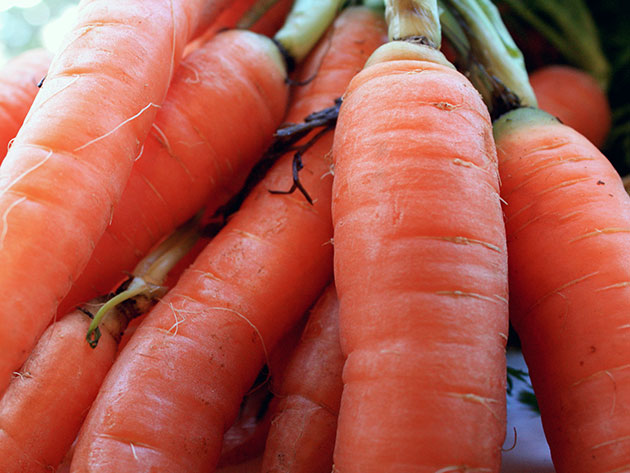
Soil for carrots.
Place under the carrots should be well illuminated by the sun and be even, but a slight slope of the site is permissible. You can not use to grow carrots beds, which last year grew cumin, fennel, parsley, parsnip , dill, kidney beans and carrots, as these vegetables quickly absorb from the ground the micro and macro elements they need, depleting the soil, and the carrot crop will most likely be lean. To be able to plant carrots after such predecessors, must pass at least three years. But after potatoes , cucumber , zucchini , cabbage , tomatoes, garlic or luke carrots grow well.
Once the plot is planned, you need to prepare the soil for carrots: for spring planting it is dug in advance, in the fall, so that it will settle until the spring. The digging is carried out to the depth of one and a half bayonets of the shovel, since if the root crop goes well into growth and rests on a dense, untwisted layer of soil, it will not break through it, but will change direction, and the carrot will turn out to be a curve. It is very difficult to dig out such carrots.

Before you plant carrots, you need to make fertilizer in the soil. They are laid out on the site before digging from this calculation: 25-30 g superphosphate, 15 g potassium fertilizers, 15-20 g nitrogen and 2-3 kg humus per 1 m 2. Then the soil is dug and left until spring. In the spring it will only be necessary to level the plot with rakes.
How to plant carrots in the open ground.
Cultivation of carrots from seeds begins with the preparation of inoculum. Before planting carrots, it is necessary to subject the seeds to processing, increasing their germination. There are four ways of presowing seed preparation:
- - they are soaked for 24 hours in warm water (30 ºC), changing it during this time at least six times. Instead of water, you can prepare a nutritious solution of the same temperature, stirring in a liter of warm water a tablespoon of ash. After the procedure, rinse the seeds with clean water, wrap in cloth and place for several days in the refrigerator;
- - the seeds are placed in a tissue pouch and immersed in water for 20 minutes at a temperature of 50 ºC, after which it takes 2-3 minutes to cool in cold water;
- - seeds placed in a bag of tissue are buried for 10 days in the ground at the depth of the bayonet bayonet;
- - Spend the bubbling of seeds, if you have a bubbler - hold them for 18-20 hours in a solution of Epin or Silka, saturated with oxygen.
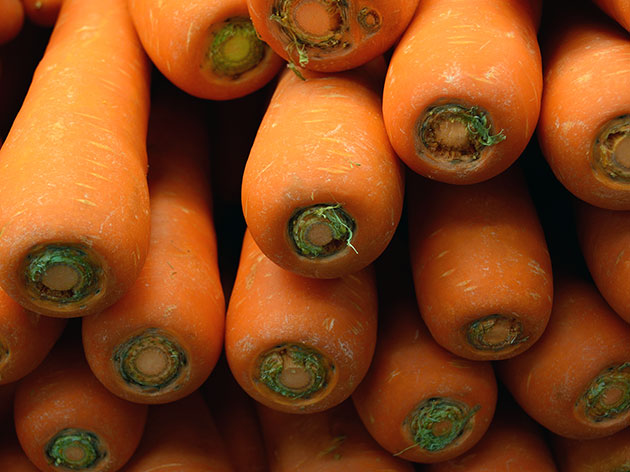
Processed by any of these methods, the seeds are ready for sowing. Planting of carrots into the soil is carried out on light soils to a depth of 2-3 cm, heavy soils require a smaller depth of embedment - 1.5-2 cm. The distance between the rows is about 20 cm. The seeds are sown 3-4 cm apart. In order to comply with this distance, you can pre-cut narrow strips of toilet paper, apply on it at intervals of 3-4 cm drops of paste from starch or flour and spread into these drops carrot seeds. When the paste is dry, the tape is bent along the entire length in half, and then rolled up into a roll. When it's time to sow, the tape is unfolded and laid in a well-moistened groove. After seeding in the soil, the site is mulched with a layer 3 cm thick, so that a crust does not form on the soil surface, which makes it difficult to germinate the shoots. There is another way to sow carrots: paper napkins or toilet paper are cut into small squares, in each of which a seed-other carrots and a granule of complex mineral fertilizer are put on a drop of paste, pieces of paper are rolled into balls, allowed to dry and stored until sowing. Lay out such balls in the furrow with the desired interval - 3-4 cm.

Planting carrots under winter.
Planting winter carrots allows you to harvest two weeks earlier than in spring sowing, but in the fall they sow early varieties that are not stored for a long time. Do this in late October or early November, and beds for carrots are prepared three weeks before sowing. After seeding the seeds, the crop is mulched with a layer of peat 3 cm thick. In the spring, the area is covered with a film and held until the sprouts are sprouted. Planting carrots into the soil in autumn is carried out only in the lungs of the soil.
CARE CARE
How to grow carrots.
Growing carrots in the open ground involves thinning out shoots with too much of their growth, frequent loosening and cleansing of the site from weeds that can cause some diseases, regular watering of carrots. The first thinning of the shoots is carried out after they have developed the first two true leaves - as a result of thinning, the distance between the seedlings should be 2-3 cm. When the second pair of leaves appears, the seedlings break through a second time, increasing the distance between them twice. If you used a paper tape or balls when planting, then you do not have to thin the seedlings. Weeding the site is carried out at the same time as the thinning, and it is better to do this after watering the site, when the soil is wet.

Watering carrots.
If you want to grow large, juicy, sweet roots, you need to know how to water carrots. Inadequate watering is the cause of lethargy and the appearance of a bitter taste. Watering carrots - the most important point of care for the plant throughout all stages of development. The depth of moistening of the site should correspond to the size of the roots, that is, the land should be saturated with water during irrigation to a depth of at least 30 cm. The lack of moisturizing provokes the appearance of root roots on roots, growing in search of a source of moisture, which affects not only the appearance of carrots, its taste qualities - the flesh becomes coarse and stiff. Excessive moisture is the cause of cracking of root crops, they are covered with small shoots, the growth of the tops is increasing. Typically, carrots are watered once a week in approximately this amount:
- - the first time after sowing the site is watered at a rate of 3 liters per 1 m²;
- - after the second thinning of seedlings, the amount of water per unit area is increased to 10 liters;
- - when the growth of root crops begins, and this occurs after the growth of the leaves, the water flow should be within 20 liters per m²;
- - for a month and a half or two months before harvesting the carrots go to the irrigation regime once in a couple of weeks with the amount of water about 10 liters per unit of area, and two to three weeks before harvesting, watering is stopped altogether.
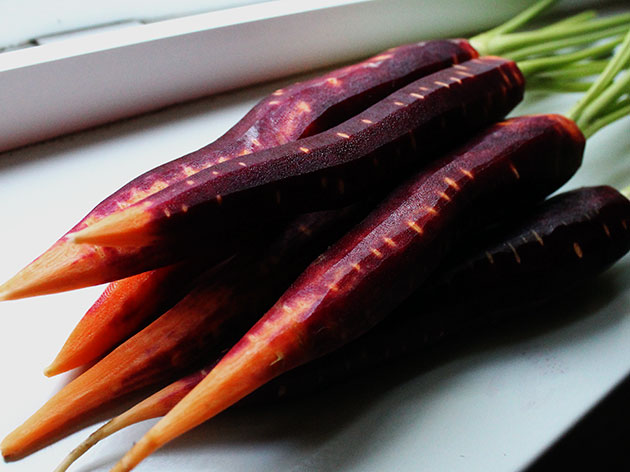
Carrot feeding.
During the growing season, fertilization of carrots is carried out twice - the first time in a month after emergence, the second time in two months. Than fertilize carrots? Fertilizers are applied in liquid form and approximately in this composition: two cups of wood ash, a tablespoon of nitrophosphite, 20 g of potassium nitrate and 15 g of superphosphate and urea to a bucket of water. The fertilizer is applied after the preliminary watering of the carrot.
Carrot treatment.
What carrots are sick and how to treat carrots from diseases and pests, you will read in the next section.
Pests and diseases of carrots
Diseases of carrots.
Carrots are affected by diseases and pests, and in order to avoid massive spoilage of root crops, you need to know what to process carrots in each specific case. Of the diseases, carrots fomoz, bacteriosis, septoriosis, gray, white, red and black rot are terrible. Bacteriosis is spread by seeds and infected plant remains, therefore remove from the beds after harvesting the tops of carrots, and seeds before cultivation, treat with hot (52 ºC) water. White, like gray rot, affects almost all vegetables, these fungal diseases are manifested most often during storage. To avoid infection, lime acid soil, do not abuse the application of nitrogen fertilizers, remove the weeds on the site, and before storing for storage, root the root crops with chalk. It is also important to observe the storage conditions of root vegetables and ensure good ventilation in the storage.

Red rot, or felt disease manifests brown or purple spots on root crops, then the spots disappear, and in their place there are black sclerotia of the fungus. This disease affects not only carrots, but also swede , turnip , parsley , beets and other root crops. It causes the disease to be introduced into the soil as a manure fertilizer. Infected with felt disease, root crops should be stored separately from the rest of the carrot. Black rot looks like coal-black rotten areas on the root, most of all it is dangerous for testes of carrots. The diseased plants are immediately removed. Preventive measures against black rot - pre-sowing treatment of carrot seeds with a half-percentage solution of Tigam.
Septoria is manifested by chlorotic small spots on carrot leaves, which eventually become brown, surrounded by a red rim. In conditions of high humidity, the disease can spread very quickly. At the first signs of manifestation of the disease, the site is treated several times with an interval of 10 days by a single-percentage Bordeaux liquid, and the severely affected plants must be removed and destroyed from the site, as well as plant residues after harvesting. As a preventive measure, good results are obtained by treating the seeds before sowing with hot water followed by a sharp cooling. And do not forget to make phosphorus-potassium fertilizers in the ground under the digging. Fomoz affects stems of testes and inflorescences of carrots, then spots of brown color are formed on the top part of root crop, gradually deepening and affecting entire root crop. Faster disease develops on light soils. As a preventive measure, treat the seeds before planting with a half-percentage solution of Tigam, and immediately delete the diseased specimens.

Pests of carrots.
Of pests, the danger to carrots is a carrot fly, winter scoop, wireworm and slugs. To get rid of slugs it is possible to collect them manually, but if the invasion is of a massive nature, jars of beer are poured into the soil, the smell of which the mollusks are slipping, or pieces of the slice gourd or watermelon , which will gather in the morning a decent slug company. To frighten off the gastropods from carrots, you can scatter over the site a pulverized superphosphate, ash or needles. The wireworms, or dark crackworm larvae, infect cabbage, cucumber, tomatoes , celery , potatoes and strawberries . The beetle itself is up to 1 cm long, black-brown with reddish elytra; its female is capable of depositing up to two hundred eggs per clutch, yellow-brown cylindrical larvae of which, up to 4 cm in length, develop within 3-5 years. To get rid of the pests, small holes are dug out on the site, half-dished grass, pieces of raw potatoes or any root crop are poured into them, the hole is poured into the ground and the place is marked with a peg. A few days later, the hole is unearthed and the larvae gathered there are destroyed. Caterpillars of winter shovels damage ground parts of carrots, and also gnaw roots and stems. In addition to carrots, the victims of caterpillars are kohlrabi , tomatoes, beets, parsley, cucumbers, onions and potatoes. Destroy the caterpillars by one of the following insecticides in accordance with the instructions: Ambush, Cyanoks, Anometrin, Revikurt, Etaphos. Do not allow the appearance of a carrot fly on the site can be placed between the rows of carrots onion.

Cleaning and storage of carrots
Harvesting of carrots is carried out in several stages. First you start yanking it in the summer for a meal, and the roots left in the ground receive more food and intensively increase the mass. Then remove the early varieties of carrots, which ripens in July. In August, it's time to clean up middle-ripened carrots, and late sorts, destined for long-term storage, are excavated from the middle to the end of September. When to dig out carrots? Choose for this warm and dry day and proceed. From light soil roots are pulled out from the tops, and from the dense soil the carrots have to be excavated with the help of a shovel. After extracting carrots from the earth, it is sorted, laying the damaged root crops for processing. In the carrots suitable for storage, the leaves are cut to the head, the roots are laid under the canopy for drying for a few days and then stored.
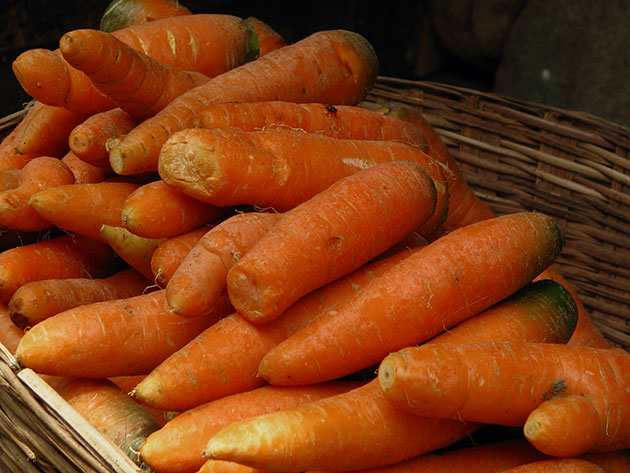
Ways of storing carrots, we devoted a section in a special article, which describes in detail how to store carrots, beets and other vegetables in winter . It is best to store carrots in a cellar or cellar in wooden or plastic boxes, pouring root crops with sand so that they do not come in contact with each other. Instead of sand, you can use moss. You can pour carrots chapped chalk and onion husks - chalk and husks of onions counteract the development of putrefactive processes.
There is another way of storing carrots - glazing with clay. Clay should be diluted with water until the density of sour cream, then each root is dipped in this chattle, laid on the grate to dry, and then gently lowered into the cellar. If you store the carrots clad in clay shell at a temperature of about 0 ºC in a dry cellar, it will remain juicy and fresh until the very spring.

Species and varieties of carrots
Contrary to the representation of the majority of carrots, it is not only a red-orange color and not always a conical shape. The orange coloring of carrots was acquired only in the XVII century, before that, in the Roman Empire, for example, white carrots grew, in Ancient Egypt purple, and in some countries of Western Europe, even black. On the early canvases of Dutch artists, purple and yellow root crops are depicted. The first orange carrot was very pale, since carotene in it was contained 3-4 times less than in modern varieties of carrots. Most recently, in 2002, breeders revived a variety of purple carrots, and it has already gone on sale. Violet pigments of anthocyanidins, which, in addition to the purple varieties of carrots, contain plants such as violet basil , beets and red cabbage, improve the work of the brain and cardiovascular system, purifying the blood of cholesterol and fats. Breeders also work on the shape and size of root crops, which today are represented by conical forms, almost round, pointed, fusiform or with a rounded end. A huge number of varieties of carrots are divided into sortotypes, among which the main are:
- – The Parisian Carothel - very early, tender, sweet and round, like radish , carrots up to 4 cm in diameter. Gives good yields even on poorly cultivated or clay soil;
- – Amsterdam - cylindrical form of root crops 2-2.5 cm in diameter, 15-17 cm in length, rounded, juicy, sweet, tender, with a small core. The only drawback is their fragility - with careless harvesting, root crops are easily broken. This is a variety of early carrots, not intended for storage;
- – Nantes - cylindrical form of root crops 3-4 cm in diameter, up to 22 cm long, with a rounded tip, with sweet and juicy pulp. Suitable for both food in the summer and for storage;
- – Berlin-Nantes - also cylindrical form of root crops, but with a sharp tip, and also larger than Nantes. Carrot in this carrot is beautiful, but it is not as tasty as the carrots of the above sortseries;
- – The Emperor - conical form of root crops up to 25 cm long with a sharp tip. The grades of this series vary greatly both in taste (can be both very sweet and not very), in the degree of leavessness and in the fragility of root crops, some of which break with careless handling;
- – Flaccus - root crops of this variety are the most powerful and long, reaching 30 cm. The weight of one root crop can be 500 g or more. The vegetation period for carrots of this variety is very large, it is well preserved, but, unfortunately, does not possess the same high taste qualities as carrots of Nantes and Amsterdam varieties.

Varieties of carrots for open ground are also divided depending on the purpose of cultivation. If you are a fan of exotics, then you will like these sorts:
- – F1 Purple Elixir - root crops with a saturated purple surface with a purple hue, inside they are usual for carrots of orange color. Root length is about 20 cm. Carrots of this variety are used for marinating and salad preparation;
- – Russian size - the exotic character of this variety (sortotype of the Emperor series) is in its size. Carrot in light soils reaches 30 cm in length and weighs sometimes about a kilogram. Despite the fact that such sizes are more suitable for fodder carrots, the flesh of this variety is sweet and juicy, the core is small, and the color is bright orange;
- – Polar Cranberry - Variety sortotype Parisian Carotel, reminiscent of its almost round form of root crops, a famous berry and containing a high amount of dry matter and sugars. Very convenient for canning and storage;
- – Minicore - an early sortotype of the Amsterdam series, which is a juicy miniature cylindrical root crop with a length of 13-15 cm with a delicate taste. Carrots of this variety are very convenient for whole-fruit canning.

For those gardeners who are interested in a greater degree not appearance, and the taste of the product and the amount of useful substances in it, the varieties are more suitable:
- – Helzmaster - a new sort of the Flacco variety, containing beta-carotene at least a third more than any other variety. The surface of the root of this variety is smooth, crimson-red, the core of an even more saturated color, the length on average about 22 cm;
- – Sugar Gourmet - a hybrid of the type Emperor up to 25 cm dark orange with a small core and a smooth surface;
- – Praline - a sort of Nanty with an increased content of carotene, almost without a core, red-orange, about 20 cm long. The taste of this carrot is beyond praise - very sweet, tender and juicy;
- – Losinoostrovskaya 13 - mid-ripening variety with a length of 15-18 cm, characterized by a good crabness.

If you are a pragmatic person and you have no time to engage in garden experiments, we offer you varieties that are resistant to diseases, yielding and well-preserved in winter:
- – Samson - mid-ripening variety of high yield of the Nanty sortotype with bright orange cylindrical roots with juicy, sweet, crisp flesh;
- – Mo - late-ripening and high-yielding varieties of the emperor's variety series with conical juicy bright orange root crops up to 20 cm long, perfectly preserved in winter;
- – Flaccus - medium-ripened spindle-shaped species with barely perceptible eyes, capable of yielding high yields even in heavy soils. Root crops reach a length of 30 cm;
- – Forto - medium-early variety of the Nantes series with smooth, cylindrical fruits of excellent taste, 18-20 cm in length. It gives stable high yields and is perfectly preserved.
According to the maturity period, carrots are divided into early, or early ripening, development which lasts for 85-100 days until full maturation, medium-ripening, ripens during 105-120 days and late-maturing, which is necessary for full maturity about 125 days. Of the early varieties of carrots, the varieties Alenka, Belgien White, Dragon, Zabava, Bangor, Kinbi, Color, Laguna and Tushon have proved to be good, from the middle-ripening varieties - Vitamin, Altair, Viking, Callisto, Canada, Leander, Olympian and Shantene Royale, Queen of Autumn, Vita Long, Yellowstone, Select, Perfection, Totem, Tinga, Olympus, Scarla.
4.5625 Rating 4.56 (16 votes)
Carrots, perhaps, one of the most favorite and often grown in suburban areas of root crops. It is difficult to imagine traditional home cooking without this colorful ingredient: many varieties of this garden culture can be stored for a long time in fresh form, representing an invaluable source of microelements and vitamins in the winter season. Is it easy to cultivate carrots on your site? Cultivation and care in the open ground for this vegetable culture have a number of features. Despite the seeming simplicity of this process, one should not forget that carrots are a rather whimsical vegetable. Unsuitable conditions, untimely watering or top dressing will lead to the fact that instead of even juicy carrots at best, a crop of fodder vegetables will be obtained. Therefore, it is so important not only to know how to plant carrots with seeds in the open ground, but also how to ensure root crops proper irrigation, care, protect from pests. When should you start seeding? What do you need to know for beginners in order to grow a beautiful and tasty carrots? Planting and care in the open field, methods of seed preparation and simple proven methods of protection against natural enemies of this root crop are collected in this article.
When is it better to start planting carrots?
The time when to sow carrots in the open ground, largely depends on the type of root. Conditionally they are divided according to the terms of maturing. It:
- early ripening or early varieties of carrots, in which, 50-60 days after the shoot, the growing season begins;
- mid-ripening (from 90 to 110 days);
- late (late-ripening) - from 120 days;
Certain varieties are quite suitable for podzimnego sowing under the film. These include, for example, the well-established "Moscow winter", "Amsterdam", "Incomparable", very tender carrots "Children's sweetness", a hybrid of "Baby F1", a cold-resistant variety "Paris carotele" and other early and medium-ripening varieties. The optimum time for the seeding sub-stations can be determined independently. Summer residents, who have practiced this method for many years, recommend waiting for the first small freezing of the soil, 3-5 cm deep. This will prevent untimely shoots. Sprouting wintering carrots can easily begin in the second half of April. To do this, a small greenhouse or simply arcs, covered with a film, is installed above the bed, after which the seeds are provided with intensive watering.
Time for normal spring sowing, of course, should be determined taking into account the climatic features of a particular region. Particular attention should be paid to such characteristics as the ability to long-term storage. For juicy early ripening varieties, such as, for example, carrots "Tushon", "Lydia F1", "Minicore F1" and similar varieties, this quality is not important. For winter stocks of this vegetable, it is preferable to choose the seeds of carrot varieties that last for a long time retain their properties: varieties of the variety "Nantes", "Orange Muscat" and "Fairy", suitable for the April planting, "Shantana" or any late varieties.
If you focus on the conditions of the middle band, then for the cultivation of the first, rich in vitamins harvest, early varieties of carrots are best sowed not later than the end of April. That is, starting around the 20th -25th. Perfect for this juicy early ripening varieties: "Amsterdam", "Orange Muscat", very sweet carrots "Tushon", "Beloved" and others.

For a crop "in reserve" carrots should be planted no earlier than May, best of all already in the middle of the month. In this case, it is recommended to choose varieties that are late or mid-ripening, but necessarily with a long period of conservation of all the properties of the root crop. Excellent can "over-winter", for example, medium-ripened carrots "Alenka", "Nantes", "Leander", "Grenada", "Vitamin". Almost all of the latter varieties are able, with proper storage, to lie throughout the winter season and remain tasty and useful until the next spring. The popular varieties Red Giant, Queen of Autumn, Mo, Flake, Incomparable, Saint-Valery and other late-ripening varieties deserve good characteristics. Particular attention should be paid to the variety "Perfection", which has high immunity to rot from moisture.
Stratification and germination
What advice should experienced gardeners use to avoid getting a curve and a tasteless "fodder" carrot? Planting and care in the open ground begins with the preparation of the seeds of this rootstock long before it hits the ground.
First of all, it is worth paying attention to when the seed was harvested. As a rule, summer residents use seeds for seeding or rather fresh "homemade", harvested from last year's harvest. If you use purchased products, then before planting carrots with seeds in the open ground, you should pay attention to the expiration date, put on the package with the seed material: a guaranteed good result in the form of an excellent crop can be obtained from the seeds, which at the time of sowing no more than 3- 4 years.
Further, a prudent decision will be to carry out preliminary training to increase the germination of the seed material. This procedure includes pre-germination and stratification, that is, the seed-holding period in special conditions. How is the stratification of carrot seeds at home? The entire process of preparation and hardening will take at least 10 days.
The first thing to do is to soak the carrot seeds for two hours. Water should be neutral at room temperature.
After soaking, the seed material evenly spreads onto a damp cloth. On top of the seeds are also covered with a damp cloth.
They should be kept in the tissues until they swell. All this time the tissue needs to be moistened. Do not allow the seed to dry out, they need to be gently stirred from time to time.
As soon as the seeds begin to peck, they must be placed in the refrigerator. Hardening in such conditions is carried out within 10 days.
There is another, long-known method of pre-germination of seed. To do this, the seeds simply pour into a bag of cotton cloth and "drop in", that is, they dig into the ground for a small depth for a period of about 10 days.
Where to plant carrots? Choose a suitable location on the site
In order to obtain a good harvest, it will be necessary to place a suitable place under the carrot beds in a section corresponding to all necessary conditions.
One of the main needs of this vegetable is a lot of sunlight. Carrot in the shade badly grows and does not have a good taste.
If winter sowing is supposed, it is necessary to make a bed not only on the illuminated, but also on the elevated plot of land. This will avoid further erosion of the seeds with melt water.
It is important, what cultures grew on this place last year. Carrots can not be grown for several consecutive years on the same bed - the soil is depleted, giving microelements to the root, so the earth should be given a "rest" for at least one or two years. In addition, natural enemies of this root can be transmitted, pests can remain in the ground from last season. For the same reason, do not put carrots after parsley. Bad "predecessors" are also beans, caraway seeds, dill, parsnips, fennel. Best carrots grow after cereals, nightshade (tomatoes or potatoes), onions, cucumbers, cabbage, garlic.
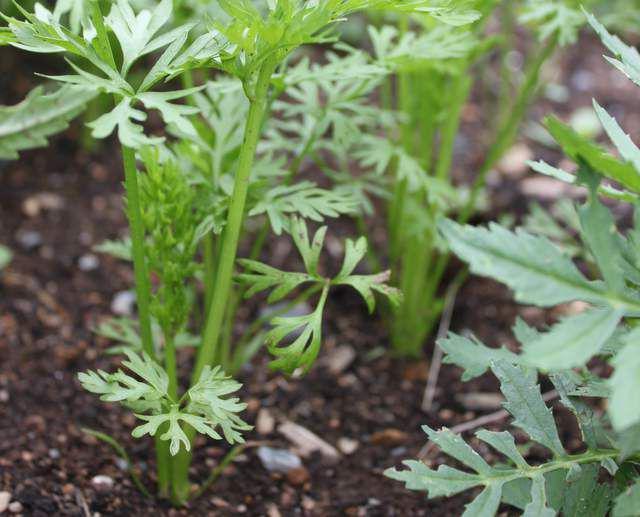
How to prepare the soil for carrot beds?
Before planting carrots with seeds in the open ground, the land should be prepared.
The site reserved for spring sowing is best to start cooking in the autumn. It will be required to dig deeply and thoroughly, selecting roots and remains of weeds, to introduce fertilizers. After such preparation in the spring it will be necessary just once again to loosen the area under the carrot patch and proceed to sowing.
The earth should be light enough, loose, this will allow the root crop to grow well, keeping an even shape. Dense soil is best mixed with sand, compost, well-repaired manure or peat.
Particular attention should be paid to the level of acidity of the soil. Excessively acid-saturated soil adversely affects the taste of carrots. The optimum level of Ph for the cultivation of this root is 6-7. Achieving the desired acidity can be done by adding to the soil known means: dolomite flour, wood ash or chalk.
We form a bed: what distance should be between the rows?
For sowing, you need to make grooves 2-3 cm deep at a distance of at least 20 cm between the rows. After the groove is spilled with a small amount of water, the carrot seeds are evenly sifted and sprinkled with earth.
Several convenient ways to plant small carrot seeds
The small size of the carrot seed material creates certain inconveniences during sowing: light seeds are not easy to fill in the groove evenly and not too often. Here are a few proven convenient ways to sow small carrot seeds.
One of the most popular, although requiring patient work, ways is to paste carrot seeds on toilet paper. Many winter residents prefer to spend several winter evenings sticking the seeds on the paste (it is most convenient to do this with a match or toothpick) and drying out the resulting paper tapes so that instead of tiresome sowing, place the "blanks" on toilet paper in the grooves and sprinkle with the soil.
Much faster and easier before sowing to stir seeds with a small amount of sand. Such a seed is evenly scattered into the groove and does not stick together.
Carrots can be sown in a paste made of potato starch. To do this, the seeds are mixed with such a cooled potato "kissel" and poured into the grooves through the kettle and sprinkled with earth.
Make granules with seeds at home. Seed material in a special shell, not requiring additional germination, for sure, every summer resident met in stores. You can create a similar "preparation" yourself: cut paper napkins (toilet paper) into small squares, in each of which place a carrot seed with a drop of paste and a granule of suitable mineral fertilizer. After that, you need to roll up the paper squares and dry them. You can also make such blanks in winter and store them in a dry place before the sowing season begins.

Fertilizers and top dressing
To make fertilizer in the soil, it is necessary before seeding carrots with seeds in the open ground. This can be done even during the autumn preparation of the site allocated for planting this root. From natural fertilizers good for this purpose is pereprevshy cow dung in the calculation of 0.5 buckets per 1 m² of land. It is important to remember that you can not use fresh manure for fertilizing the carrot patch: it will unnecessarily increase the acidity of the soil, which will cause the roots to grow curved.
For pre-fertilization, nitrogen fertilizers mixed with phosphates can also be used. For example, based on 1 m², you can add the mixture in the following dosage:
- superphosphate (granules) double - 2 tablespoons;
- dolomite flour - 2 tbsp;
- wood ash - 2 tbsp;
- potassium sulfate - 1 tbsp;
- saltpeter (sodium) - 1 tbsp.
Periodic feeding of carrots can be carried out using a mixture of mineral additives in two stages.
Three weeks after the emergence of sprouting in the soil between the rows, a solution is made from the calculation:
- 1.5 tbsp. l of double superphosphate;
- 1 tbsp. l potassium sulfate;
- 1 tsp. urea;
- 10 liters of water.
Half a month after the first feeding, you need to make a solution at the rate:
- 1 tbsp. l azofosca;
- 1 tbsp. l potassium sulfate;
- 10 liters of water.
Supplementary feeding can also be carried out with an organic mixture - a solution of chicken manure with water (1:10) with the addition of superphosphate. The resulting additive must be insisted, and then diluted again with water 1:10. The resulting composition should also be introduced no more than twice.
In addition, growing carrots can be fed with a solution of boric acid with water in the proportion of 1 tsp. for 10 liters. To make such composition it is necessary two times for a season: in the first decade of July and to the beginning of ripening of root crops (the first days of August).
Important! The prescribed dosage should be strictly observed, using nitrogen fertilizers. The excess of nitrogen when growing carrots leads not only to roughening of root crops, but also contributes to an increase in the level of nitrates.
Watering rules
Carrots, like many root crops, can suffer from over-drying of the soil, and from an unlimited amount of water. The correct watering of the carrot is to observe the "golden mean".
Before planting, water the bed with planted seeds often, but with a small amount of water.
Watering after emergence is required only once a week, not abundantly: the ground should be impregnated with water no more than 30 cm deep. Excessive amount of water is guaranteed to cause rooting cracking, and if you spill the beds insufficiently deep, it will lead to the formation of many small shoots and yield a crop of so-called hairy carrots.
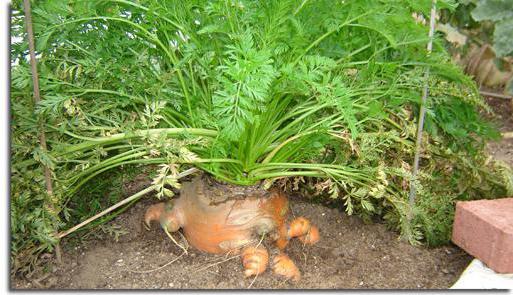
Lack of moisture, a long absence of watering affect the taste of the crop: the carrot becomes very stiff, loses sweetness.
In excessively hot summer weather, watering can be carried out a little more often, as the soil dries up, about 3 times a week.
With sufficient humidity experienced gardeners recommend to give up irrigation about 3-4 weeks before the harvest of carrots. It promotes long-term storage of root vegetables, and also improves the taste of ripe carrots.
Thinning, loosening, hilling
To gather even and large carrots from the beds, growing and care in the open ground must necessarily include the removal of weeds, the rooting of root crops and the timely thinning.
First of all, do not neglect the timely regular loosening of the carrot. Despite the fact that already in preparation for sowing the soil was made as light as possible, after the first shoots it is necessary to provide the roots with sufficient oxygen. Loosen followed by moist soil, after watering or rain, and extremely carefully. Delicate, firm "roots" of carrots in this period are located near the surface, inaccurate loosening can easily damage them.
With the same caution should be applied to thinning - an important "operation", which allows to obtain a crop of large roots. It should be followed after the appearance of strong first "leaves" of carrot leaves. It is important to remember that if the thinning is wrong, you can injure the remaining roots, which will lead to undesirable sprouts and to the harvest of "horned" carrots. Therefore, it is necessary to carry out this procedure according to the following rules:
- thin out only in well-moistened soil;
- to extract the "extra" root crops you need to slowly, pulling them upwards, to swing or sharply pull the root from the ground can not be;
- thinning is better in two steps: for the first time it is enough to leave the distance between the roots about 3 cm, after 14-16 days the procedure should be repeated, leaving the largest carrot at a distance of about 4-5 cm from each other.
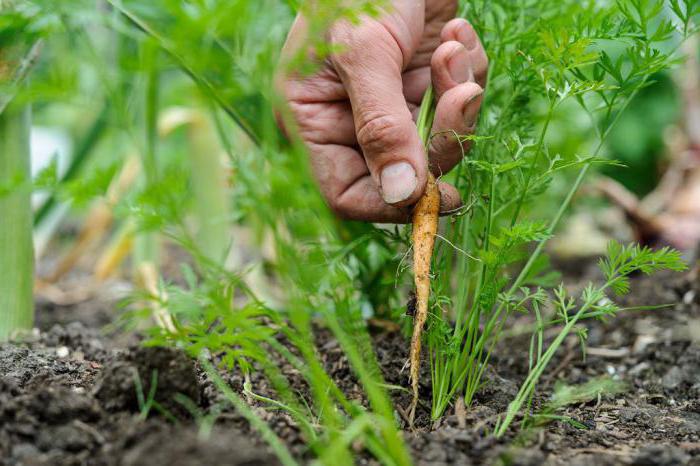
Spooning carrots, covering the roots with soil, is necessary to avoid the formation of a greenish upper part. If this is not done, in the fruits with the "green stripe" is formed substance solanine, which during winter storage gives carrots a bitter taste.
Pest control: how to protect crops from insects and diseases?
One of the main natural enemies of this root crop is a carrot fly. There are several simple, including preventive, methods of fighting this insect:
- do not leave the removed tops of carrots and weeds after thinning near the beds;
- mulch growing roots with clean straw or pour the surface of the bed with one of the natural remedies for carrot fly: tobacco dust or hot pepper;
- it is recommended to place onion as a "neighbor" next to the carrot, its sharp smell of a fly also does not tolerate.

The aphids are planted on the tops and overhead parts of the plant, feeding on their juices. From the above insects it is recommended to carry out treatment with insecticides (Bitoksibatsillin, Lepidotsid), but not more than 2 times a month.
The wireworm, which is the larvae of a beetle-click, spoils the crop of root crops, gnawing at them the courses. In order to collect most of these pests, dig holes "traps", in which are placed a small amount of well-overripe herbal mass and a piece of raw potatoes. The top of the hole is covered with earth and left for 2-3 days, and then the larvae are removed and destroyed.
Garden slugs are less dangerous than wireworm, however, it is better to struggle with them. As a "trap" you can lay out pieces of pumpkin in the garden or dig a few containers with beer near the beds. Slime, for the night gathered on the smell of "trap", it is easier to collect and destroy. Well help to ward off slugs from carrot beds needles of needles, scattered between the rows.
An adult insect is not threatened with vegetables, but its caterpillars gnaw on the aerial part of the root crops. Get rid of them will help insecticidal treatment with special drugs ("Etafos", "Cyanoks" and others).
In addition to insect pests, there are a number of diseases that are susceptible to carrots. Here are the most common lesions of root crops:
- Gray rot is a fungal disease. It requires urgent "treatment" - treatment of all root crops in the garden with a disinfectant.
- White rot is a consequence of an overabundance of nitrogen, which occurs when a large number of nitrogen-containing fertilizers. To neutralize this disease, special preparations containing copper should be introduced into the ground.
- Bacteriosis and alternaria (black rot) are diseases that result from the use of poor-quality seed. Prevent them by pre-disinfection. Treatment is spraying with fungicides.
- Fomoz (or dry rot) - is caused by fungal pathogens and practically does not lend itself to disinfection. Preventive maintenance is the preliminary application of fertilizers with the content of potassium.
- Felt disease occurs after the collection of carrots and prevents the storage of root crops. You can fight it by spraying with fungicides.
Timely prevention and treatment of these diseases, together with proper care, will yield a crop of even sweet carrots that can survive until spring.
Carrots are one of the most useful vitamin vegetables. In the recipes of home preparations it is found almost everywhere. Therefore, every vegetable grower necessarily allocates a site for planting an orange root crop.
How to plant carrots in an open ground to get a rich harvest? There are several rules, respecting which you will not remain without harvesting this vegetable.
Preparation of carrot seeds
Before starting to plant, it is necessary to treat the carrot seeds before planting in the spring. General recommendations on that.
For sowing use last year or biennial seeds. Older seeds lose their germination almost half. In order to distinguish the young or old before you seed material, use your nose)) The smell of young seeds is more pleasant and has a strong flavor.
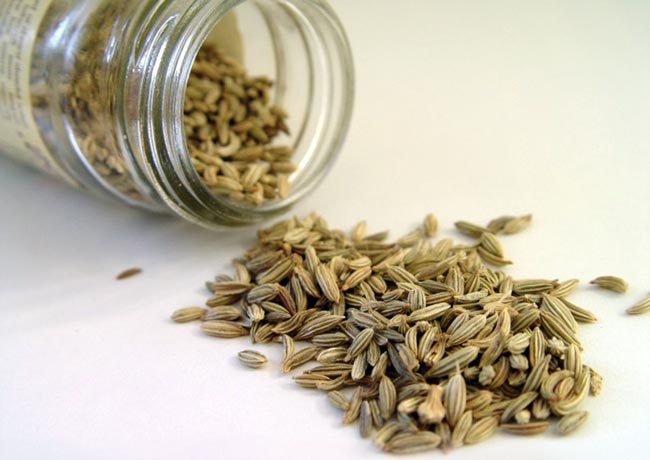
Root crop refers to slowly sprouted crops, so it is necessary to prepare the carrot seeds for planting in the spring. Three methods are used:
1. Seeds are lowered into a solution of common salt (50 g of salt are taken per liter of water). All the surfaced seeds are drained off with water, these are "pacifiers," and the settlers are transferred to a gauze bag and washed well. Then they are immersed for 10-15 minutes in hot water, then in a cold water. Lay out on a wet sacking, cover them and leave at room temperature to germinate.
During this time, the seeds must be washed twice. The first is clean water at room temperature. The second time microelements are added to the water (copper sulphate and manganese sulphate at 0.03%, boric acid 0.06%, and amber 0.004%). Dried seeds are dried.
2. Dry seeds should be covered in a cloth bag and for 12 days before planting, dig in the garden to the depth of the bayonet bayonet. The earth must be moist and cold.
When you are ready to plant, the bag is dug from the ground. Seeds must be dried for half an hour, decomposing on dry matter, then immediately sow. You will be pleasantly surprised to see the first shoots on the 4th-5th day.
3. Some truck farmers cover carrot seeds with a nutrient shell, it turns out, something like seeds in granules. The shell is made from liquid mullein and nutritious soil. Seeds are treated 5 days before planting.
For this purpose in a one-liter jar mix 2 tbsp. spoons of peat and humus in a ratio of 1: 1, 1 tbsp. a spoonful of Mullein and 2 teaspoons of dry carrot seeds. The can is tightly closed and vigorously shaken for 1 minute. Additionally add 2 more times a mixture of peat, humus and mullein, continuing to shake. Seeds are covered with earth "shell", then they are dried on paper.
Using one of the above methods, you will not have a question how to plant carrots so that it quickly rises, because after such treatments sprouts appear faster than when planting dry seeds.
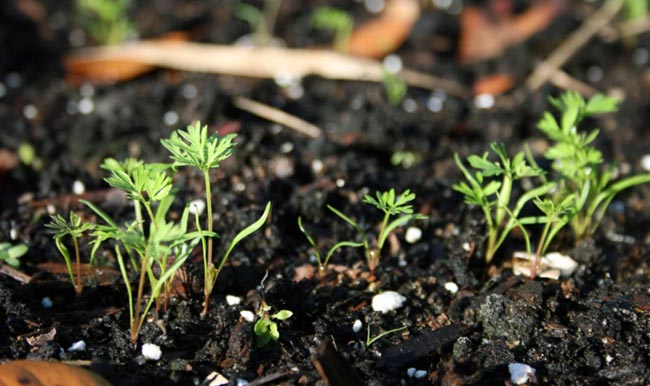
Preparing the soil for planting carrots in spring
A higher yield of root crops is obtained on cultivated soils with neutral acidity (it is easy to determine by the growing wild plants, they usually grow chamomile, coltsfoot, creeper field, clover, clover, sow) and good drainage, and also on light sandy loam and loamy.
Do not forget about the crop rotation.
The best predecessors consider potatoes, cabbage, tomatoes, beans.
Under carrots you can not make fresh manure rich in nitrogenous compounds, otherwise it will yield a lush tops and small ugly roots with several roots. Therefore, it is best to introduce manure a precursor culture.

In advance in the summer or early autumn, place for sowing is dug and brought humus fertilizers or infertile fertilizers to the infertile lands - 1 teaspoon of nitroammophoska per 2 m of row or superphosphate (30-50 g / m2). Or add a mixture of nitroammophoska and potassium sulfate (50 and 20 g / m2), but nitrogen fertilizers should not be carried away.
On acid soil, carrots do not grow, if you have a soil with high acidity, be sure to add dolomite flour to it.
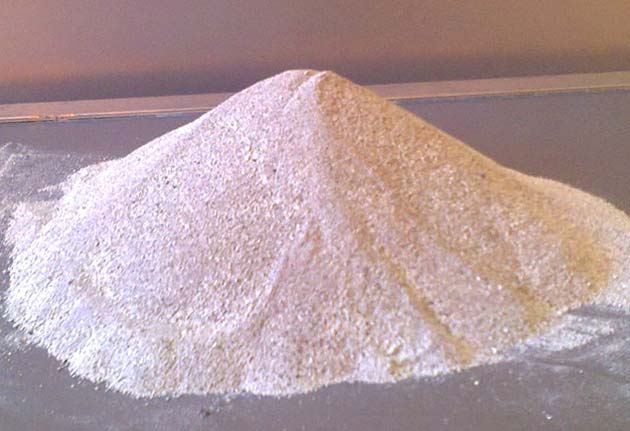
In the spring, the land is loosened and leveled. Grooves make a depth of 2 cm at a distance of 20-25 cm from each other. If you have heavy soil in the garden, then add 10-12 kg of sawdust soaked in urea (30 g per 10 liters of water), 3 kg of peat and half a bucket of sand.
Seeds are sown in the open ground when the air temperature reaches +8 ̊C at night and 14-16 ̊C in the daytime.
The optimum soil temperature for planting carrots in spring is 7-9 ̊C.
This temperature is usually in late April - early May. In the southern regions, carrots can be sown earlier, but remember, the higher the soil temperature, the faster the moisture leaves it, which has a bad effect on the germination of the seeds.
Now consider how to properly plant carrots in the open ground.
Many gardeners because of the lack of free time often sow dry seeds immediately in the ground. With this method, the seeds will sit in the ground for about 1.5 months.
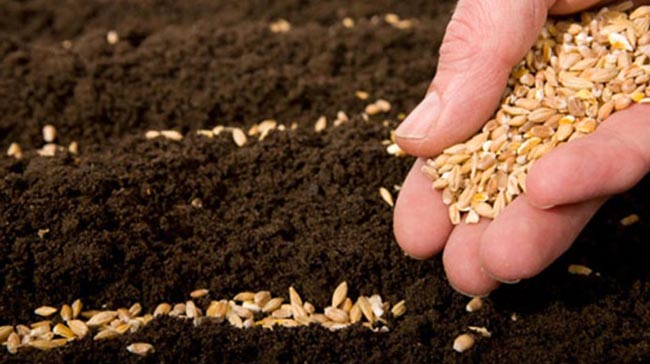
How to plant carrots with seeds
Seeds are sown in moist soil, you can shed it with a weak solution of potassium permanganate, at a distance of 2-3 cm with a pinch. Some seedlings of seed pinch are sown separately from each other, others are sown with a continuous line. The furrows are covered with peat, a mixture of peat with sand and well watered from the watering can.
To accelerate the germination, the crops are covered with a film, which is immediately removed when the first shoots appear. With this method, it is necessary to thin the carrot several times a season. The first thinning should be done when the first real leaf appears in the seedlings, and then it is necessary to water after the procedure.
But not everyone likes to thin out carrots, and many do not get up to wrest healthy, strong shoots. Therefore, for many, the actual question is how to plant carrots, so as not to thin out? Especially this method allows you to economize the seed, and the harvest will not have an ugly fused shape.
Ways of planting carrots without thinning:
1. Carrot seeds are mixed with seeds of fast-growing crops - radish, lettuce or spinach. Add a little river sand and sow in the grooves. Fast-growing vegetables are harvested during ripening, and there is room for carrots.
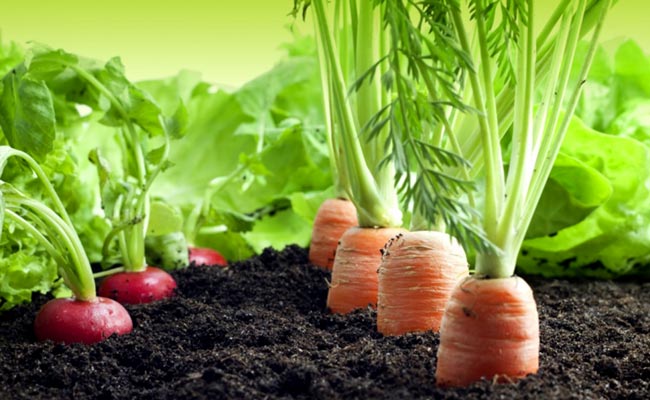
2. Seeds of carrots on a paper strip are glued with a paste. One minus is a very long and time-consuming process of gluing small seeds, but the tape can be purchased already ready in the store, the main thing is that you find it.
How to plant carrots on a tape
Acquired ribbon in the store before planting is soaked in the gauze for 24 hours, during this time the seeds will become saturated with moisture and will quickly ascend.
Then, her or a self-prepared tape with seeds is pulled along the groove and sprinkled with earth. Be sure to water. Plant the tape with the seed material early, until the earth is wet.
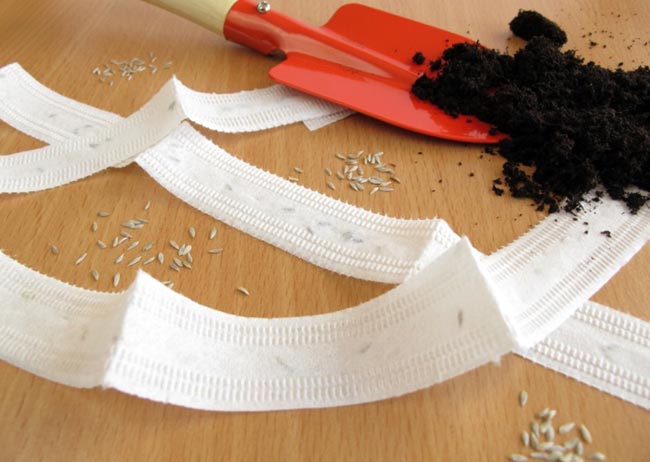
3. Innovative way.
In water, dissolve the mineral complex fertilizer, add flour and cook the paste. Cool it and pour the prepared seeds. A paste with seeds is placed in an empty plastic bottle or a confectionery syringe. The mixture is squeezed out with an even line into the grooves. Thanks to the laws of physics, seeds do not stick together, but are located in a mixture at a distance from each other. In this case, the seeds are in a nutrient medium.
4. Seeder for planting seeds.
It is sold in specialized stores or, if there are gold hands and savvy in truck farmers, create such a device independently at home.

But progress does not stand still, to facilitate the process of sowing small seeds were invented dragee seeds or seeds in granules. They are dragees in which one seed is placed. The dragee consists of a hydrogel with the addition of fertilizers with microelements, with growth the shell collapses. The dragee is larger, it is convenient to sow one piece, and is colored in a bright color, so it is perfectly visible on dark ground.
How to plant carrots in granules
Using a stick, pits are made 5 cm apart. The depth of the fovea should be approximately 2 cm and the same diameter. Be sure to spill the patch with water. To destroy the outer shell must be very high soil moisture.
In prepared grooves put on 1 granule, if you are afraid that it will not rise, then insure, and plant 2-3 granules. Be sure to in this case, to thin the carrots as they grow. The decomposed seeds are sprinkled with earth and watered again.
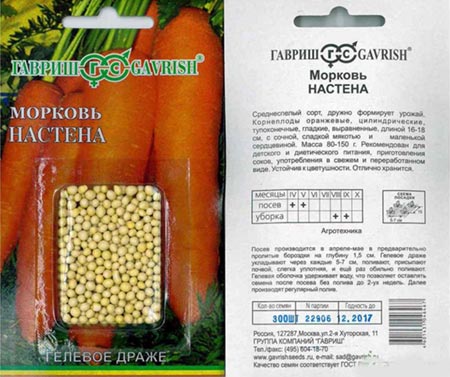
As you can see, it is possible to grow carrots in the open ground in various ways. To get a rich harvest of carrots do not forget about care - watering, weed control, loosening of the soil. And then "your girls from the dungeon" will fall for glory.
